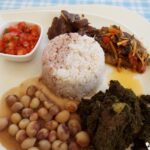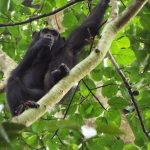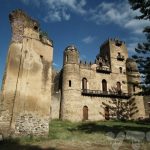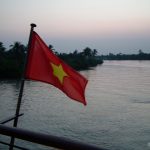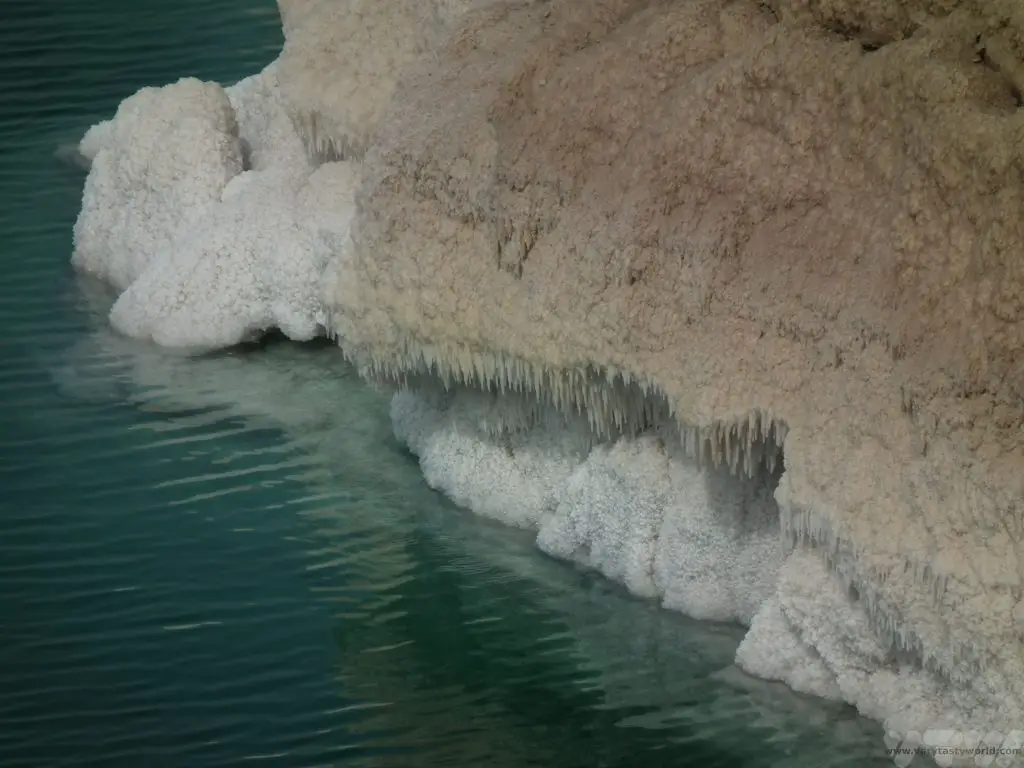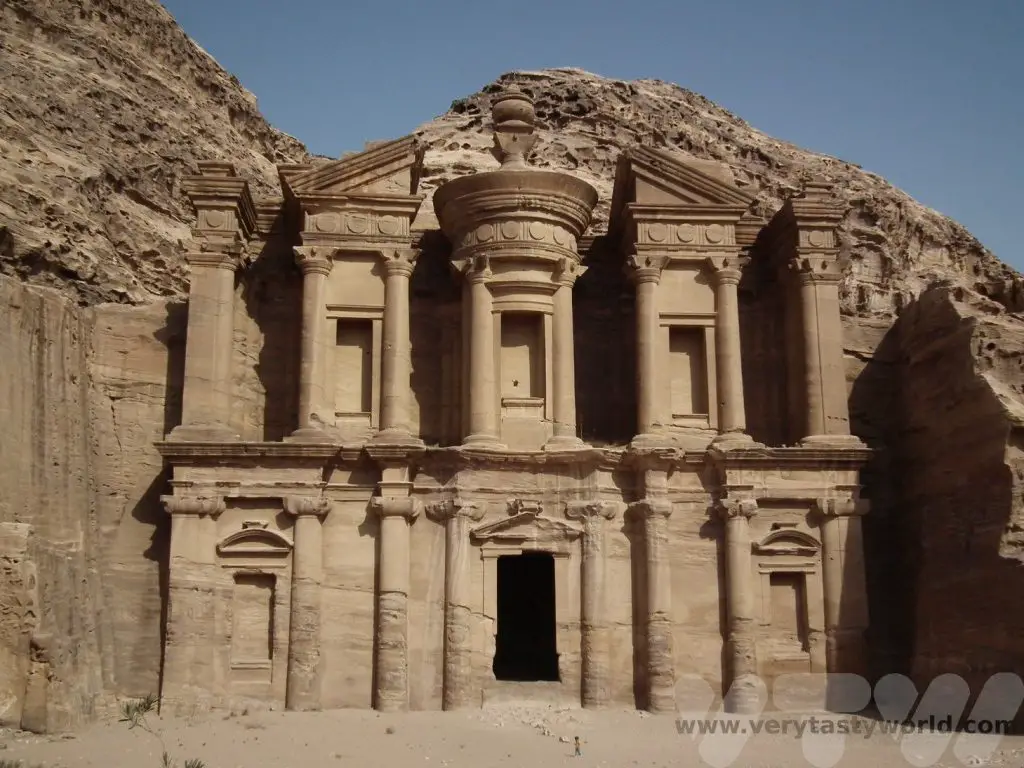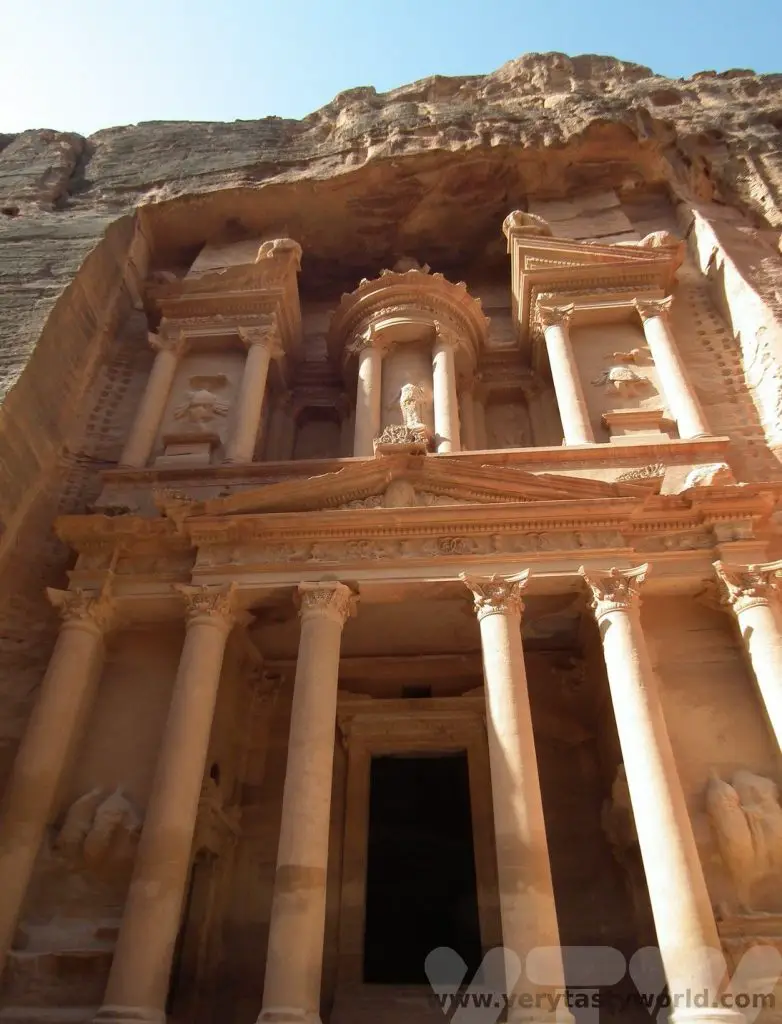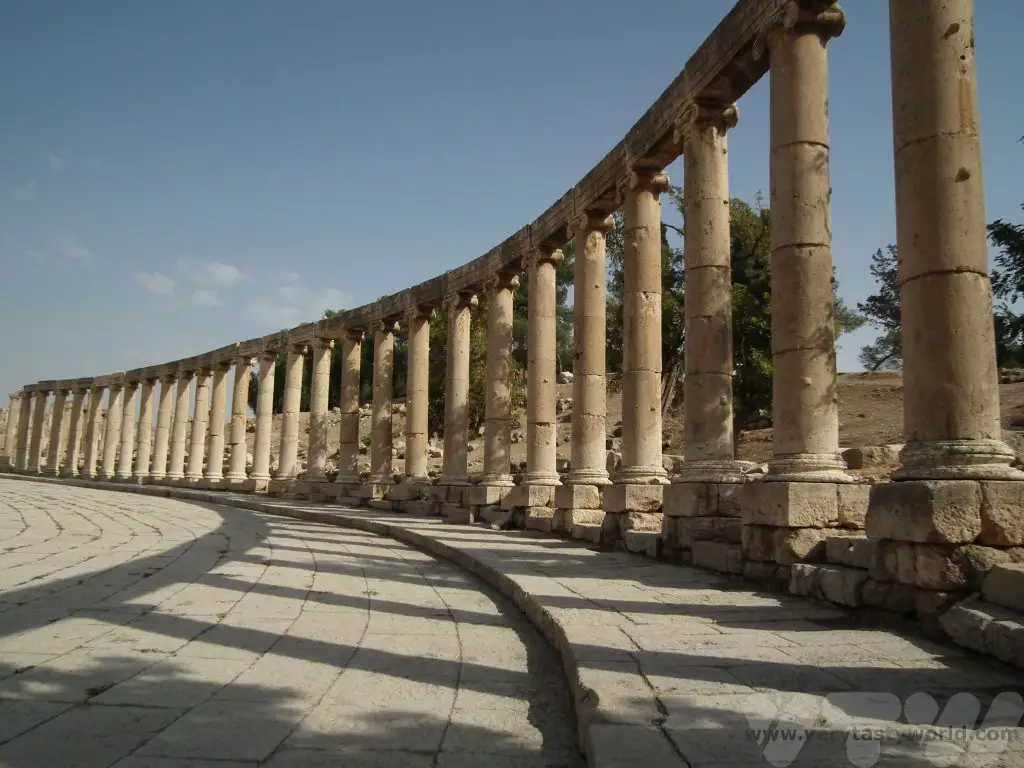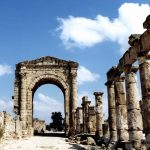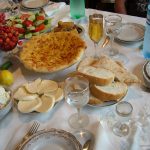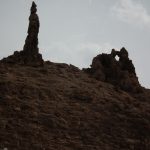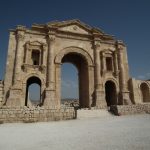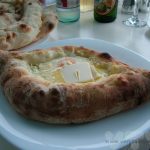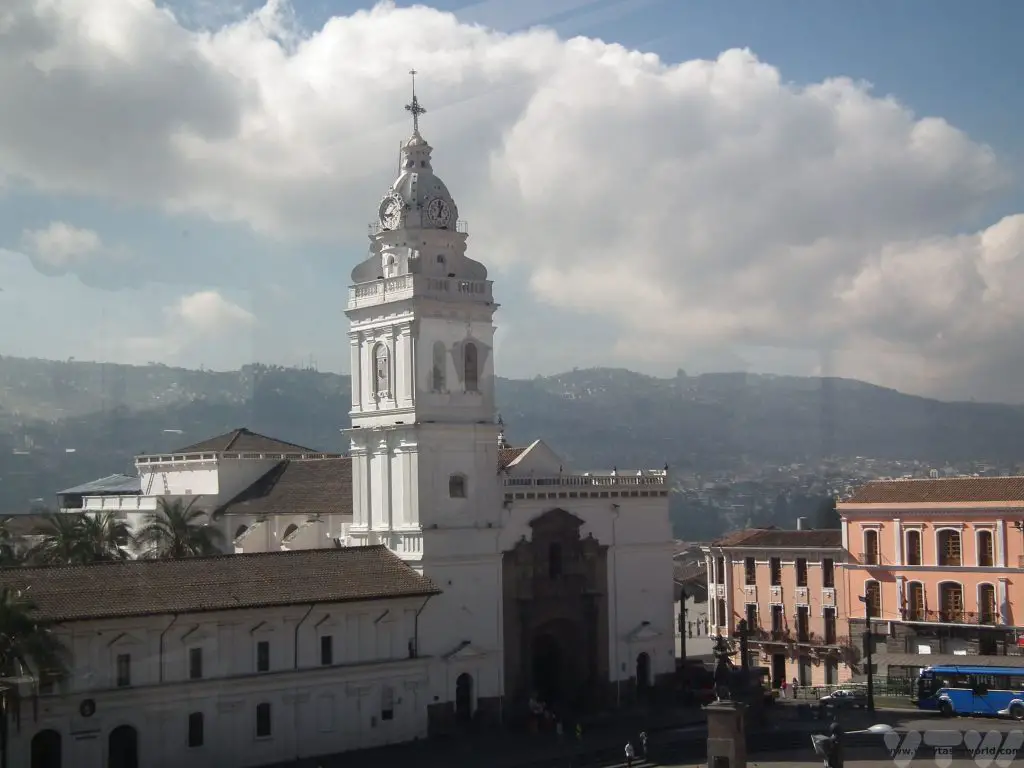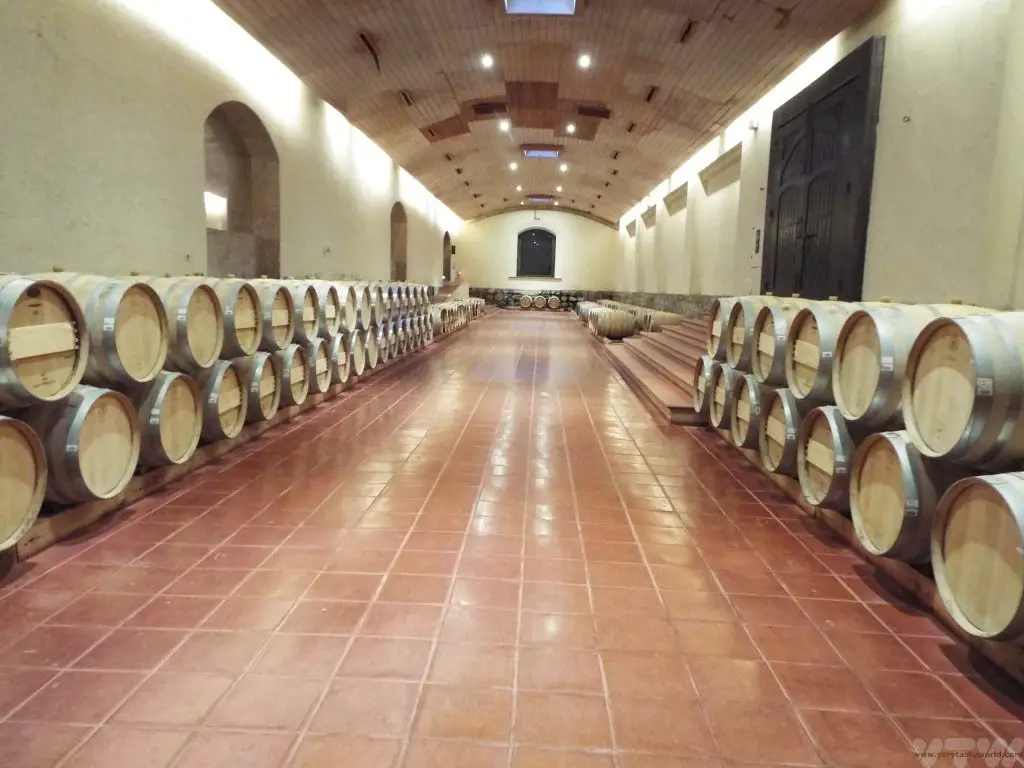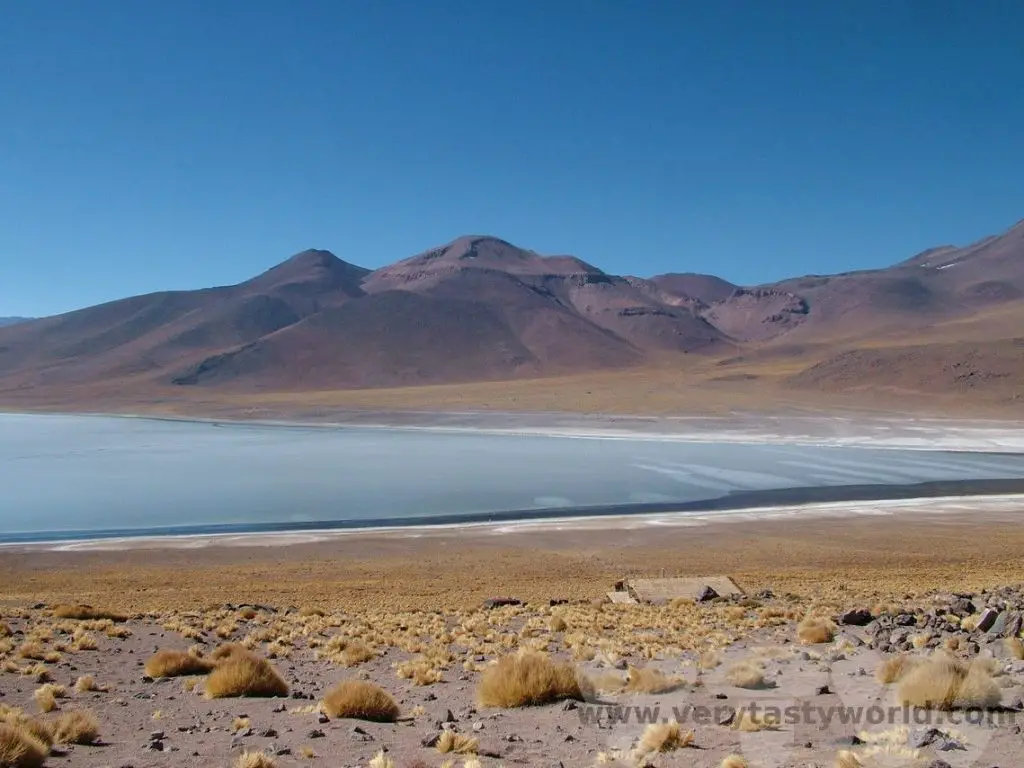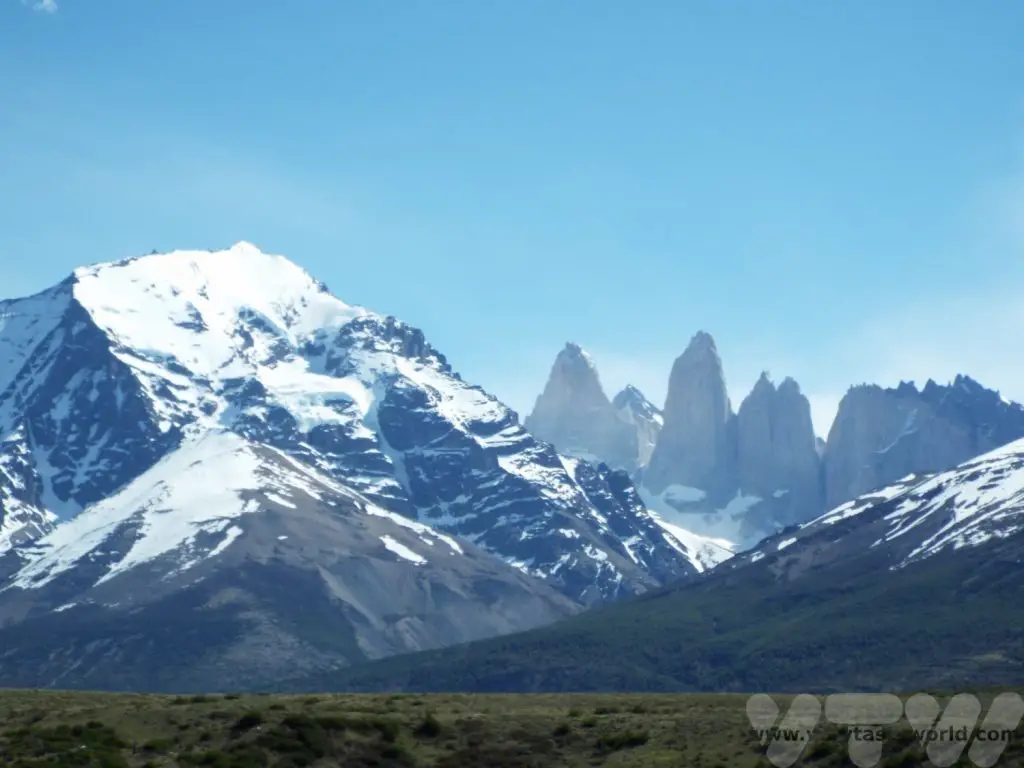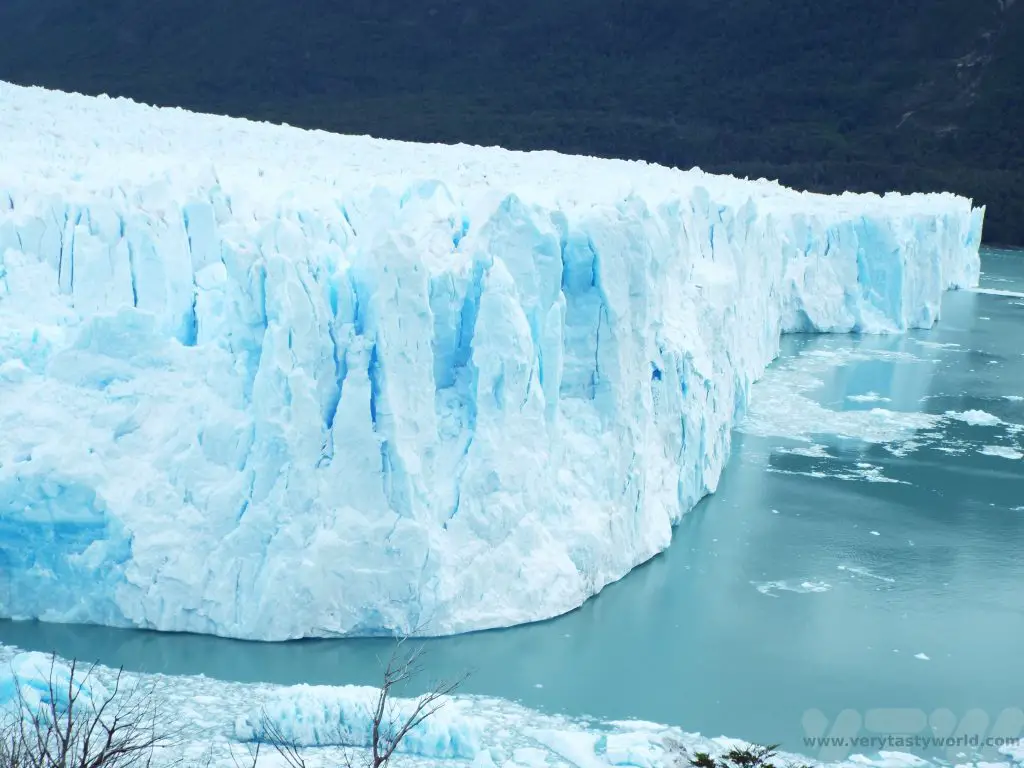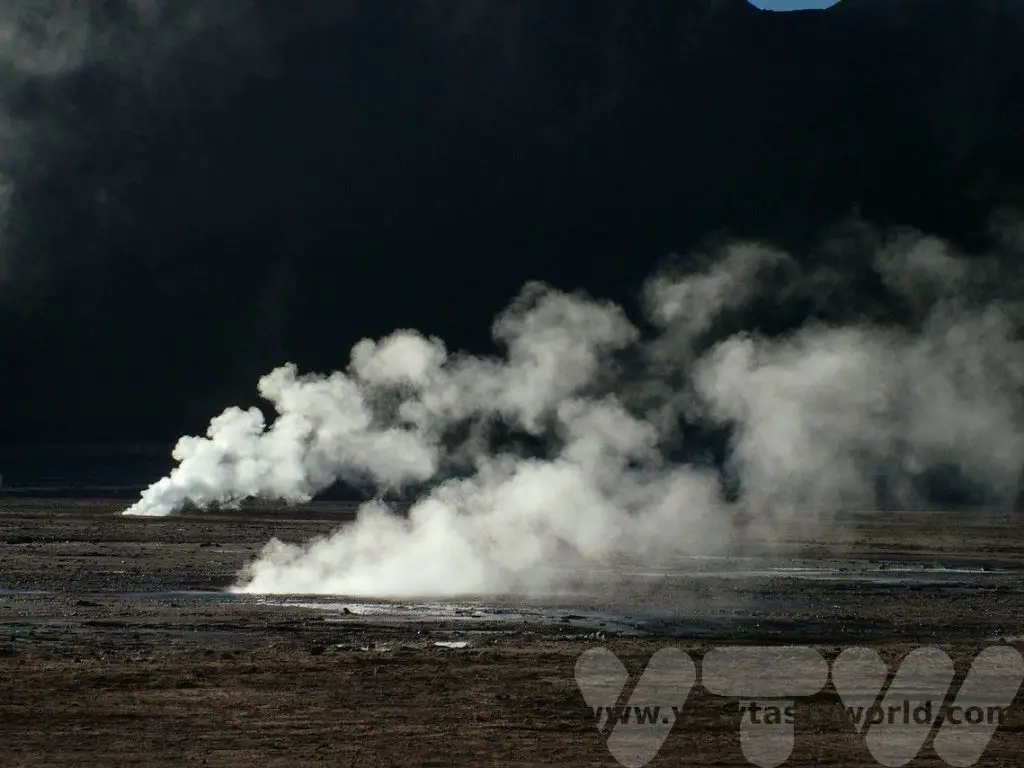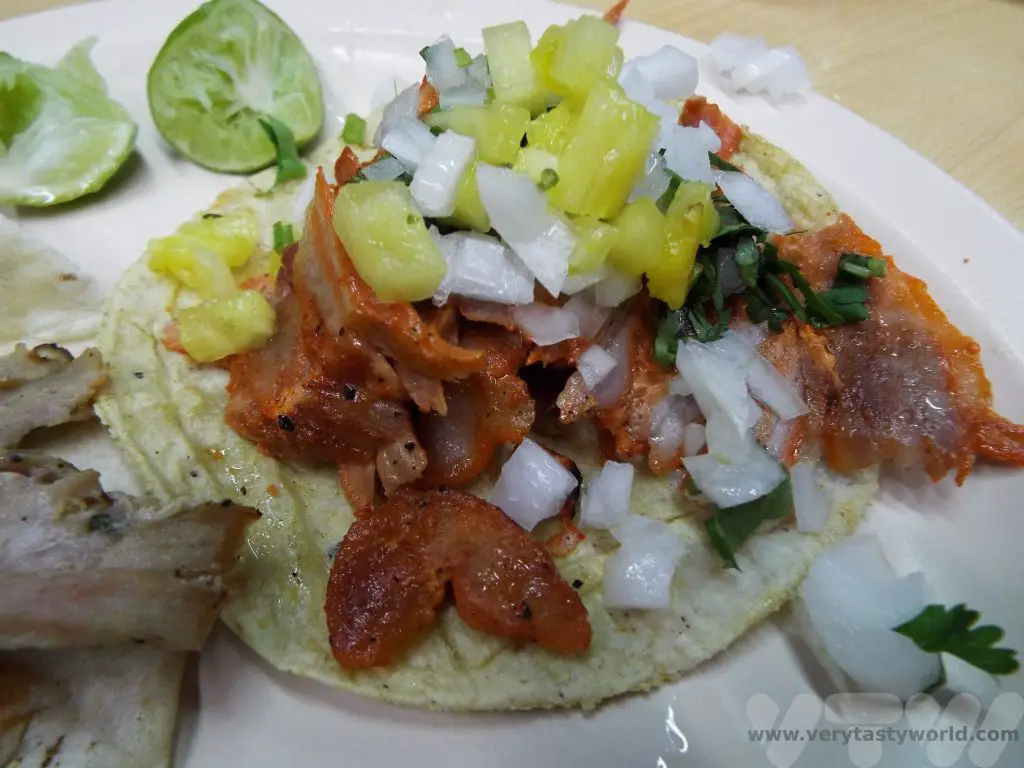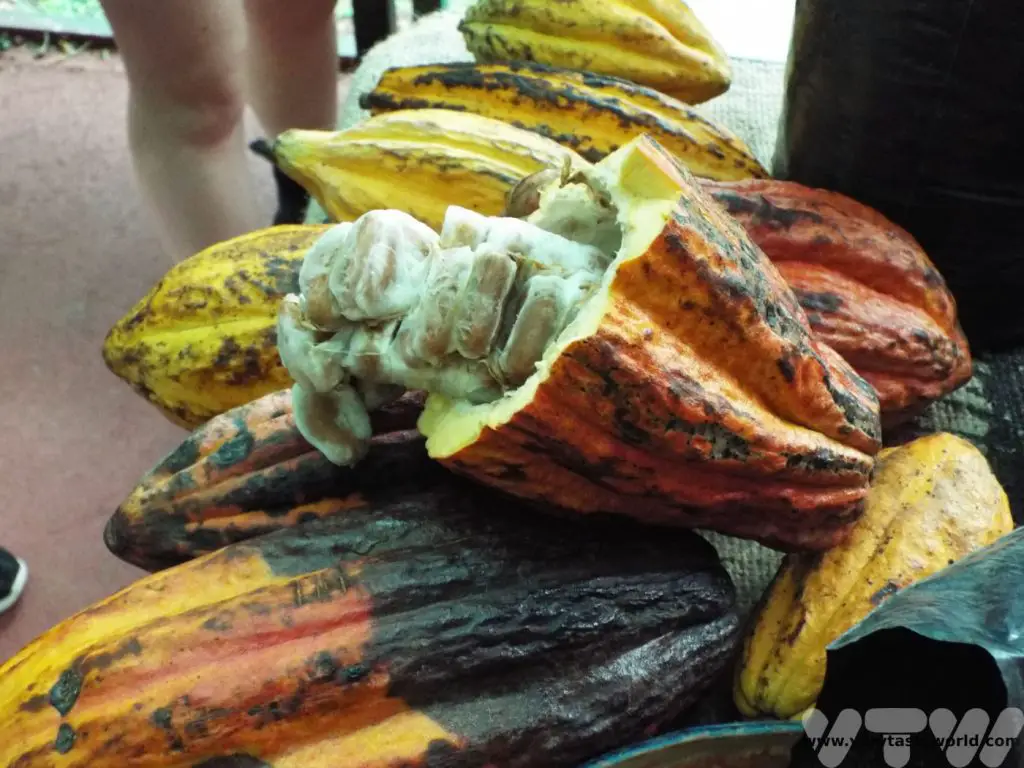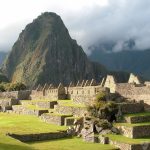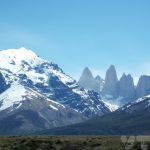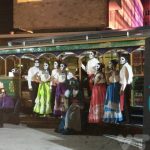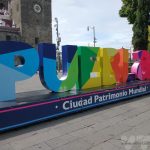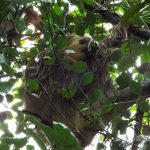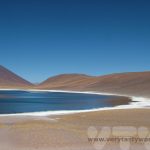Wild and Desolate: Namibia’s Skeleton Coast
Namibia is a perfect country for a fly-drive holiday. The roads are wide and, outside the towns and cities, virtually empty, which makes for remarkably easy driving. You can drive for thousands of kilometres across spectacular scenery, encounter amazing wildlife and even take yourself on safari. You don’t even need a 4WD, we hired a saloon car which was just perfect. Many of the roads are constructed of gravel so it’s advisable to pack a spare tyre (or two) just in case you get a puncture. If you do get a puncture you can be sure that any passers-by will stop to help you fix it but you can’t guarantee that you will encounter a passer-by. We visited Namibia before SatNavs were widely used so we navigated with old-fashioned map. When we got hold of our map of the entire country it seemed surprisingly basic – just showing the main roads. But we soon discovered that the map was definitely detailed enough for travelling vast distances as there are very few roads. The map also helpfully pinpointed the location of petrol stations. We made a point of topping up the tank at every opportunity – our car had good fuel economy but distances are long and you really don’t want to run out of petrol.
One region that we particularly wanted to explore was the Skeleton Coast, the western coastline where the Namib desert meets the South Atlantic. It is a place that is truly wild and lives up to its name – where the skeletons of animals and shipwrecks are scattered across the sandy beaches. The coastline is incredibly long and large parts of it totally inaccessible. From Swakopmund we drove north as far as it was possible to drive.
And at either end we ate our most and least decadent meals, two nights apart.
We had driven to Swakopmund from Windhoek via the amazing red sand dunes of Sossusvlei and spent a couple of days there, having a great time taking part in all sorts of adventuresome activities – you can parasail, go hot-air ballooning, ride the dunes on quad bikes or even go along the coastline to Walvis Bay and kayak with seals. There are loads of tour operators in town that offer activities and you can make bookings with them directly. Some activities, such as the hot-air ballooning need some notice, for others you can just roll up on the day.
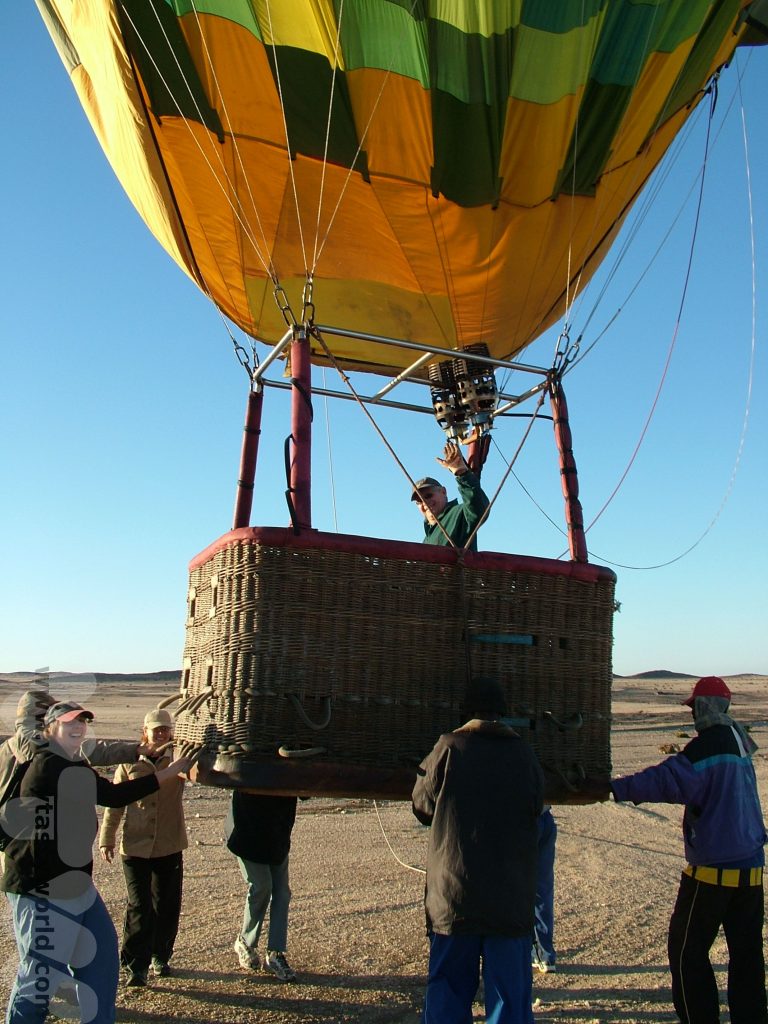
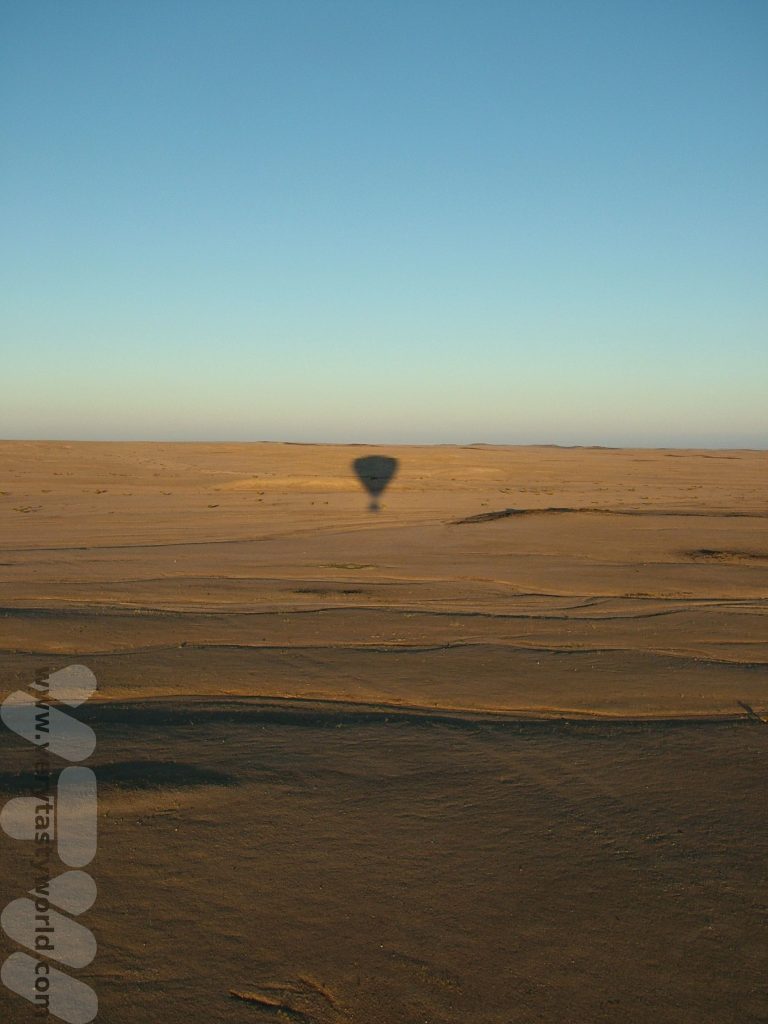
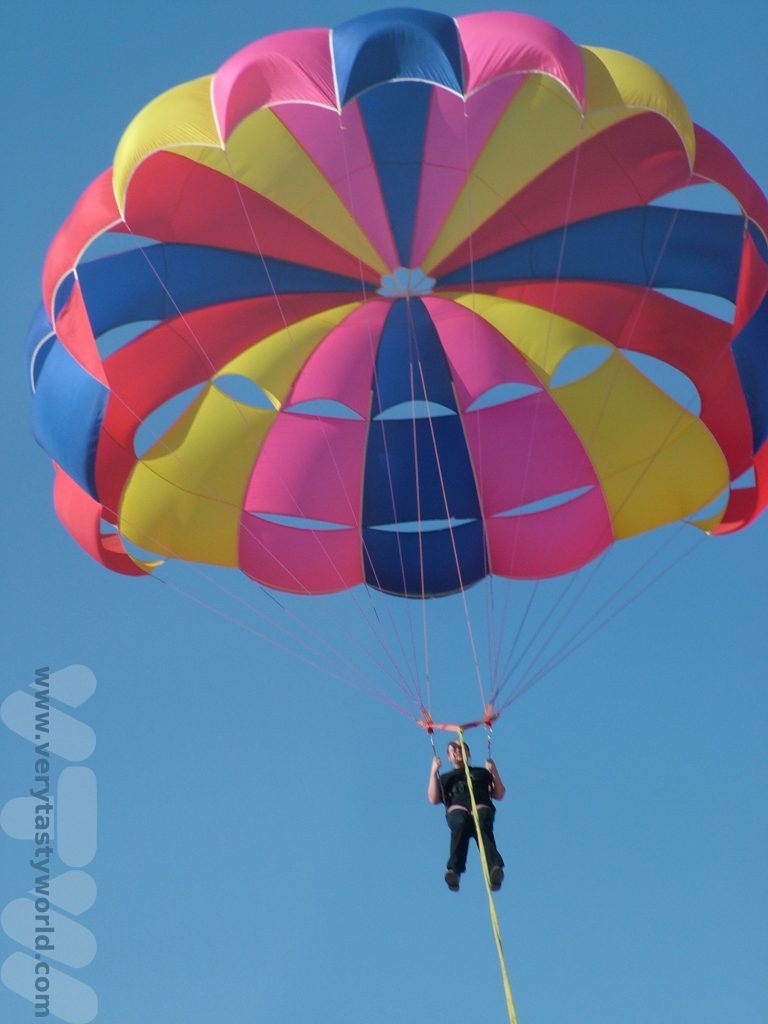
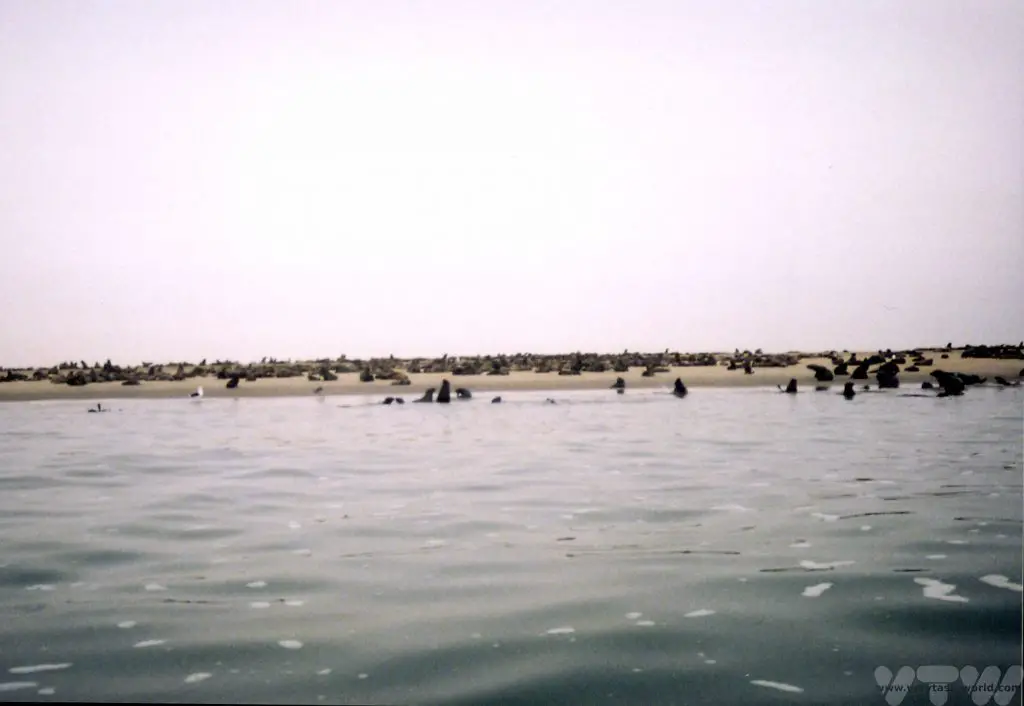
Swakopmund is the largest town on the coast, it’s small and friendly and bears an influence of German colonial architecture. We had our most decadent meal in this town. The Tug restaurant is located on a jetty right on the coastline and, as its name suggests, was constructed around a tug -boat – a Danie Hugo to be precise. Being right on the coast, naturally the restaurant specialises in seafood. And you can look out to the Atlantic as you dine.
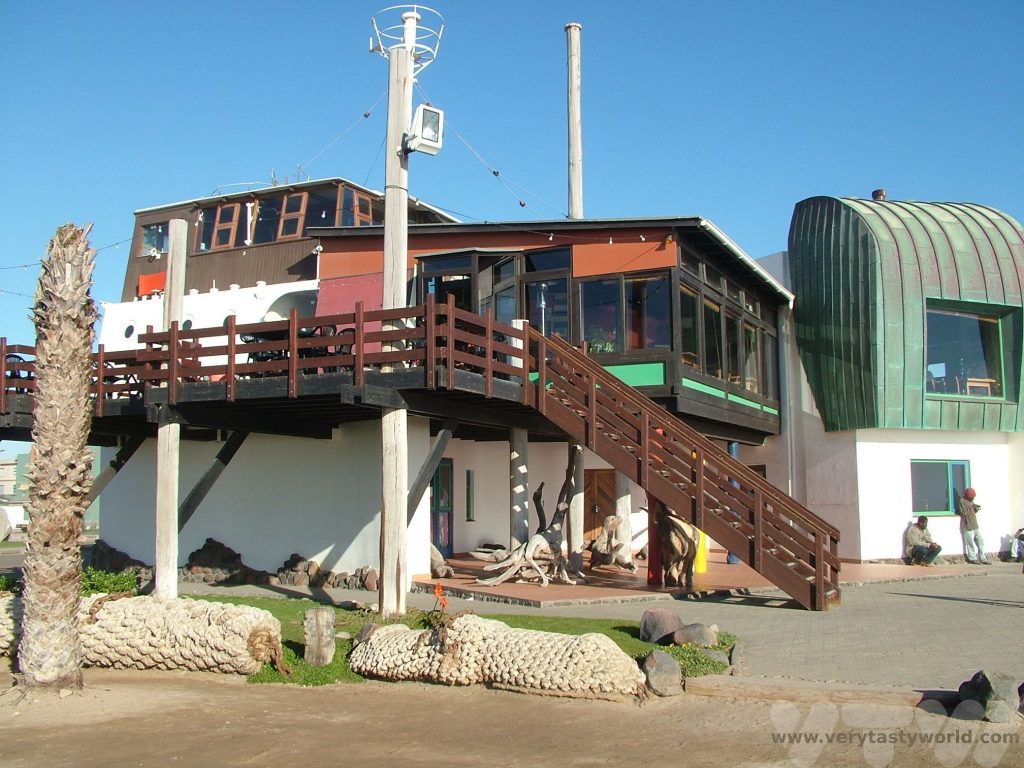
We ordered a sharing dish – the seafood extravaganza: rock lobsters, kabeljou and kingklip fillets, juicy prawns cooked in their shells and the softest melt-in-the-mouth calamari we had ever eaten. All washed down with a crisp white wine. We visited some years ago and a quick glance at the most recent menu online reveals a slightly different offering to the one we dined on but it’s lovely that an indulgent seafood feast is still available.
We left Swakopmund early the next morning as we had a long drive ahead of us. It was going to be a full day’s journey along an isolated gravel road through the Skeleton Coast national park. We passed by the smelly Cape Cross seal colony and onto the park.
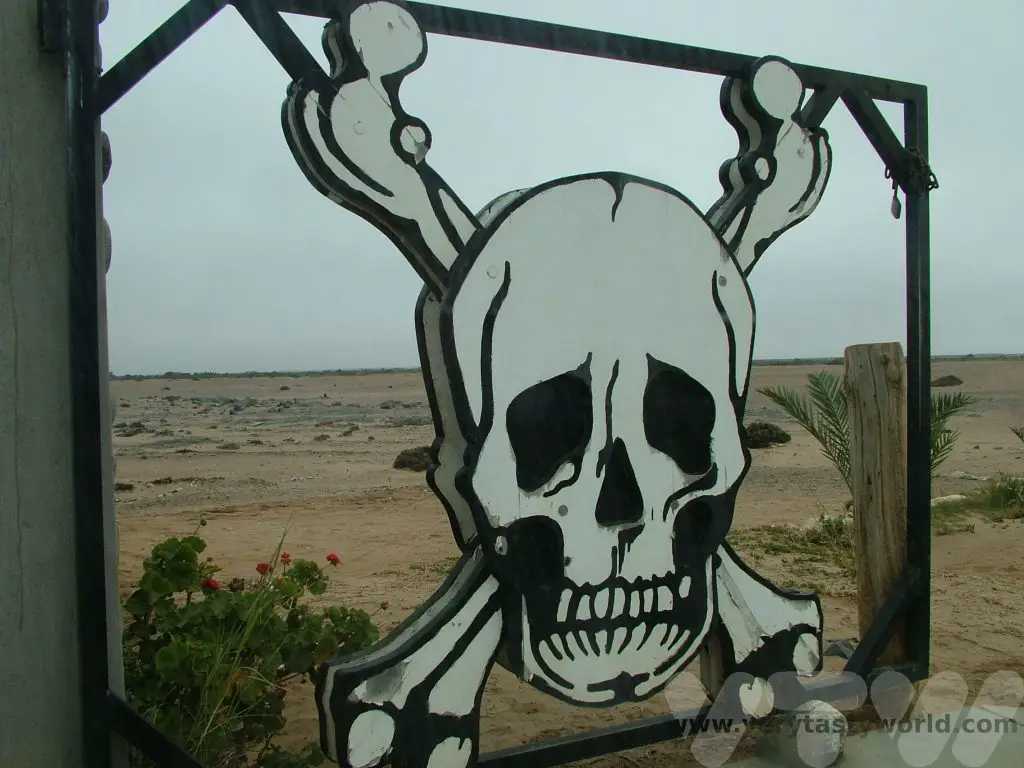
The gates were ominous. You need a permit to enter the park and we had to register our arrival. There are different types of permit – if you plan to stay on the coast you need to obtain an overnight permit.
Once we had entered the park we saw just one other car in the entire day. We didn’t suffer a puncture but were glad that we had spare tyres in the trunk of the car in case we had needed them. We were driving a two-wheel drive car so kept to the road but stopped off at various points along the way to explore the wild, windswept beaches, observing shipwrecks and other skeletons. The area is quite often misty as the heat of the desert hits the cold air above the ocean and it adds to the enigmatic nature of the stark landscape.
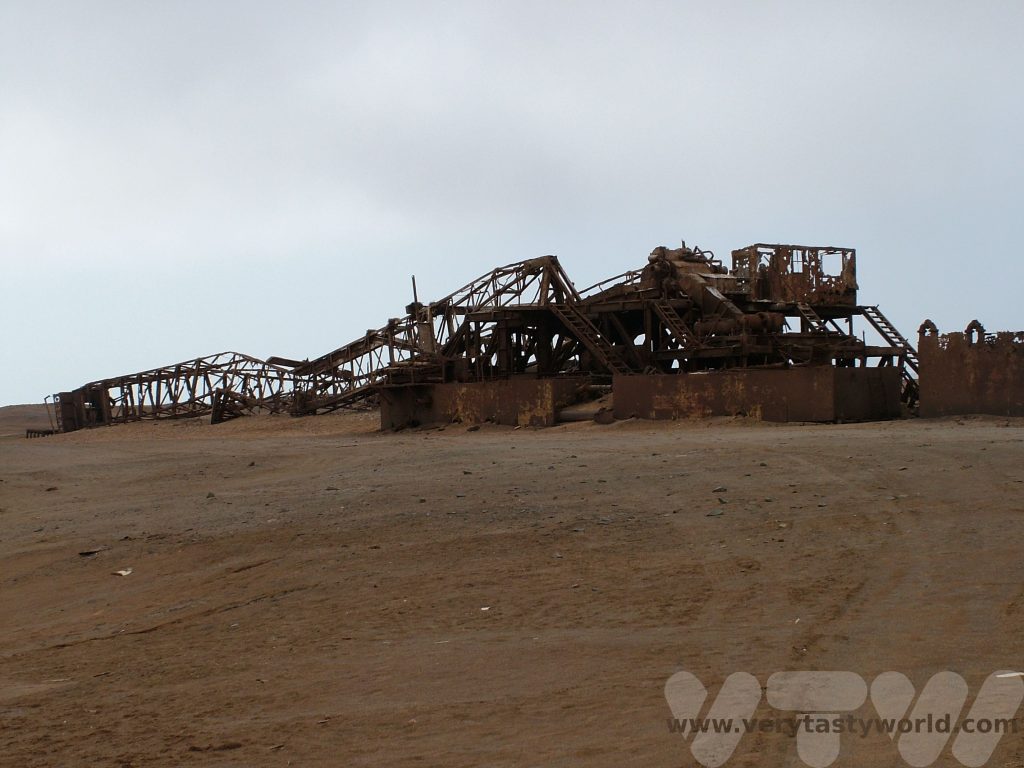
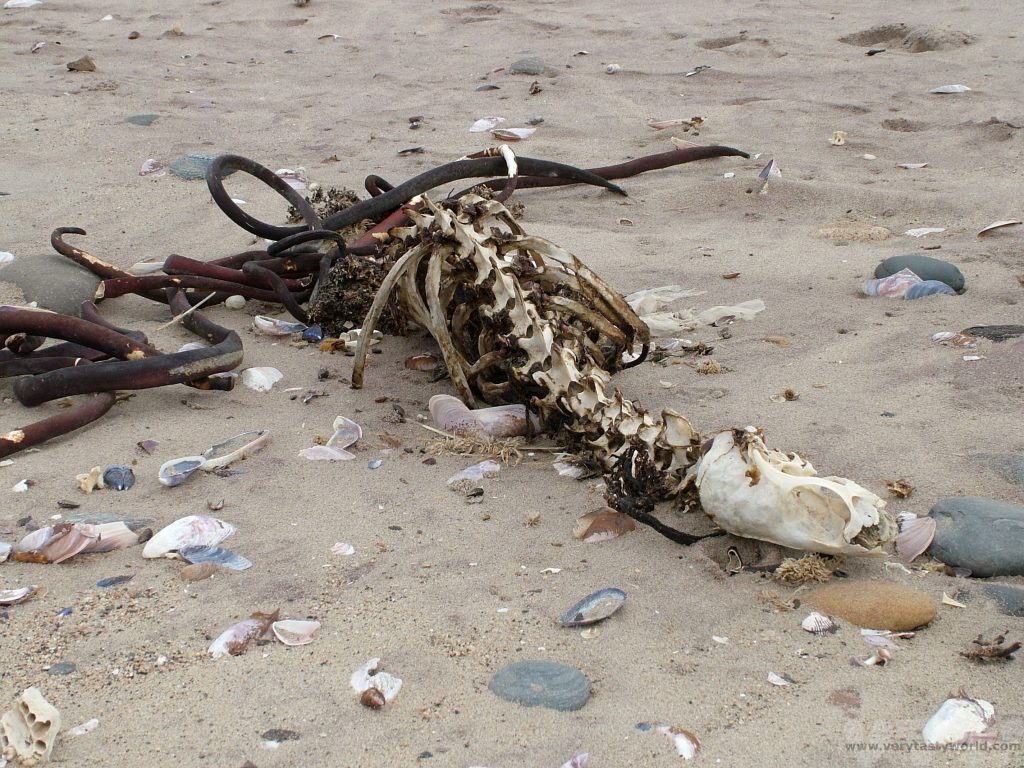
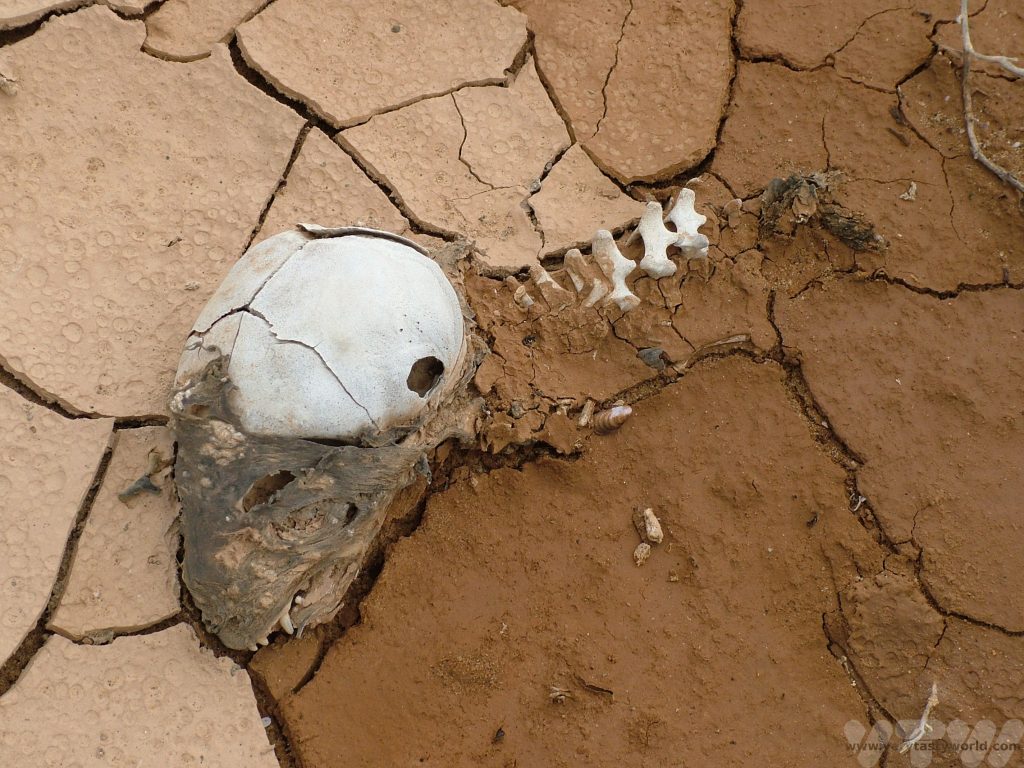
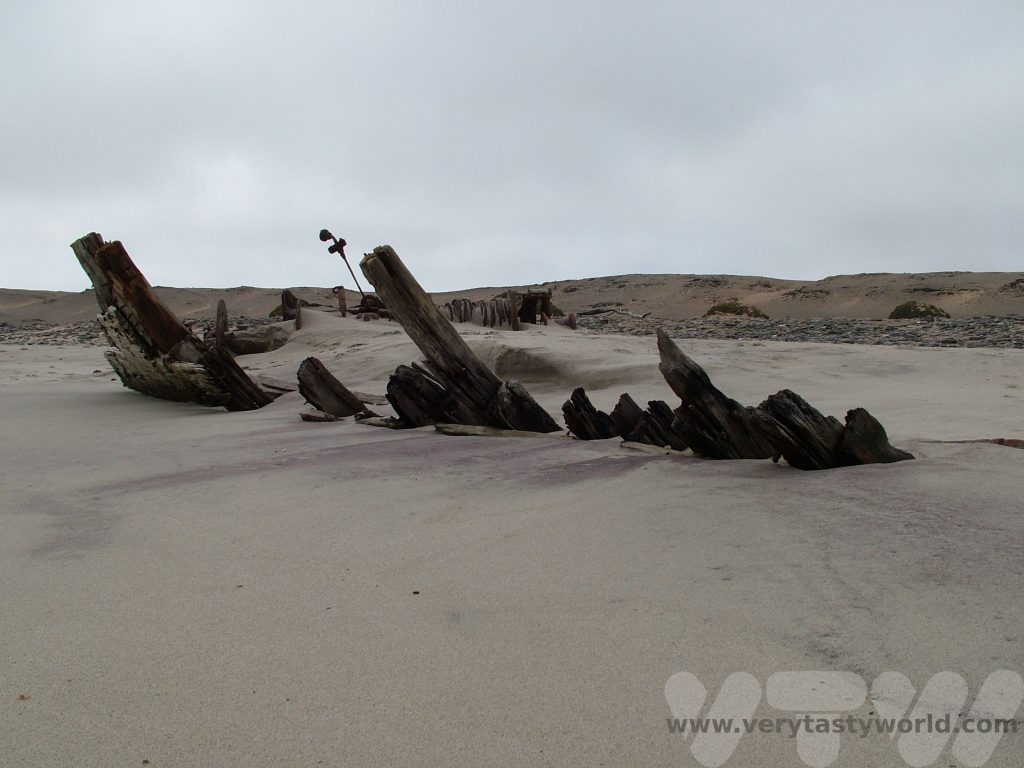
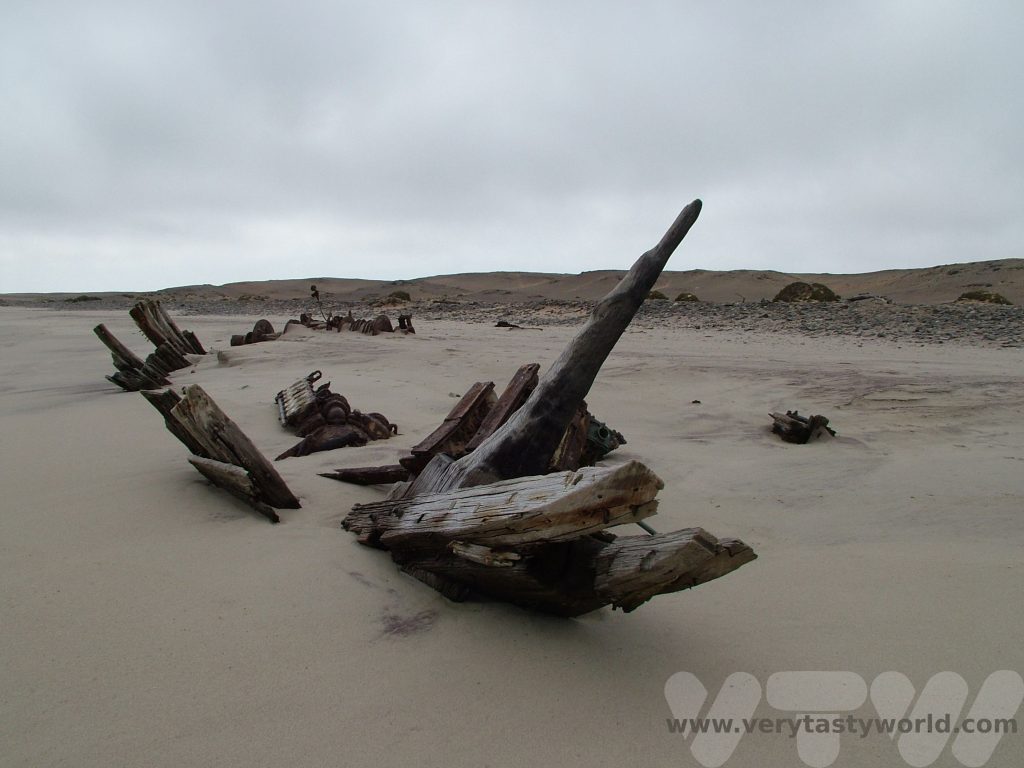
Our final destination was the Terrace Bay resort, near the Uniab River Delta. It’s very remote and popular with anglers but there are things to do if you’re not into fishing. We enjoyed walking along the beach and across the dunes. The accommodation in chalets wasn’t luxurious but was perfectly fine. The car was filthy.
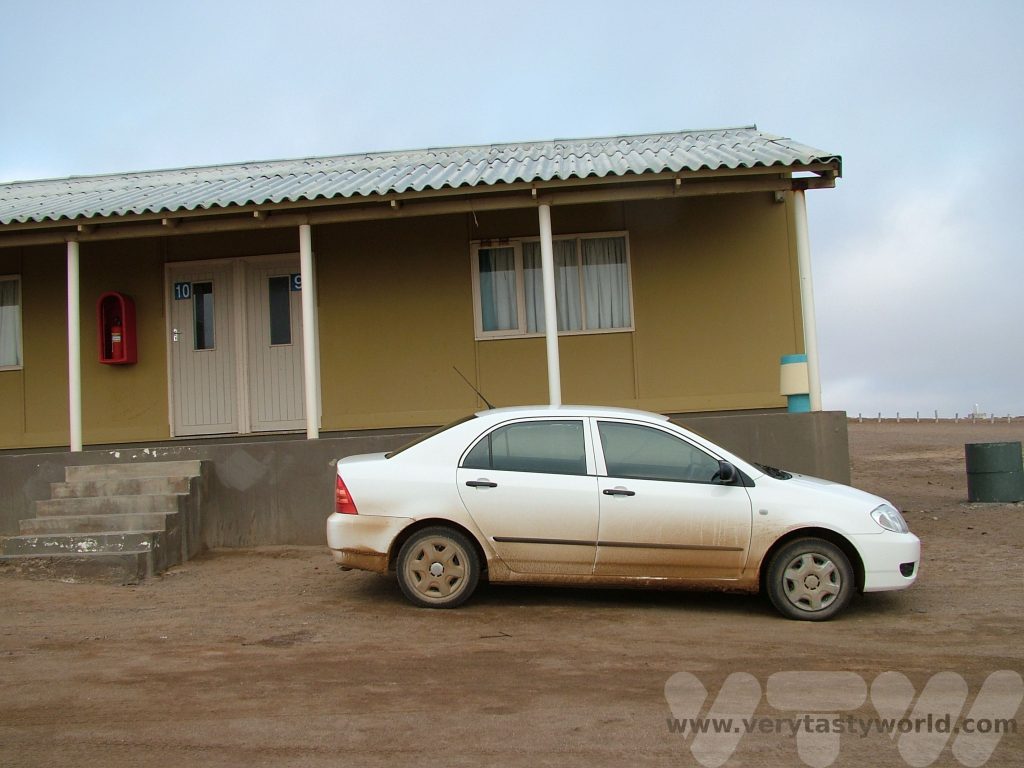
Food was taken in a communal dining hall. Because the area is so remote, we weren’t expecting a brilliant meal. It may have been a far cry from the seafood extravaganza but our dinner was good old fish and chips and they were absolutely great. The dessert in the desert was that 1970s classic, Angel Delight. I have no idea what Angel Delight actually is. It feels like it basically comprises a powder to which you add milk and stir to get a soft, creamy dessert. It was our first Angel Delight in decades and – don’t tell anyone – it was surprisingly good.
It is possible to explore further along the coast but not by car – you would have to fly. After leaving the Skeleton Coast we headed inland towards Damaraland, stopping to admire the famous Welwitschia plant some of which can live to be over a thousand years old, and eventually the Etosha National Park.
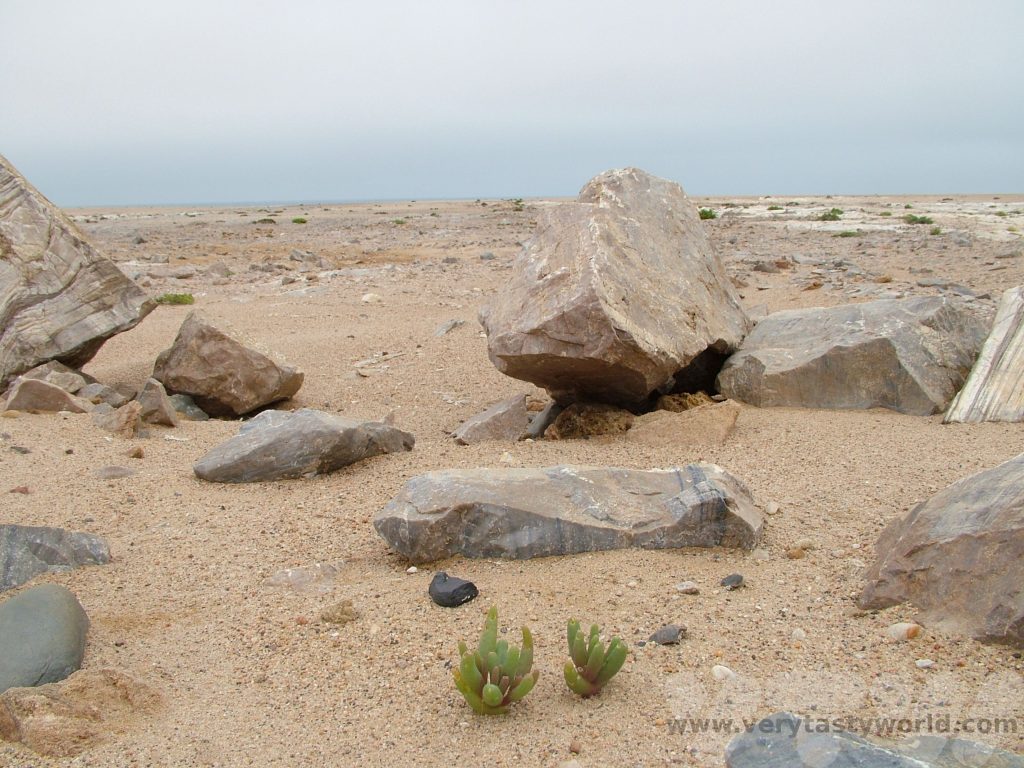
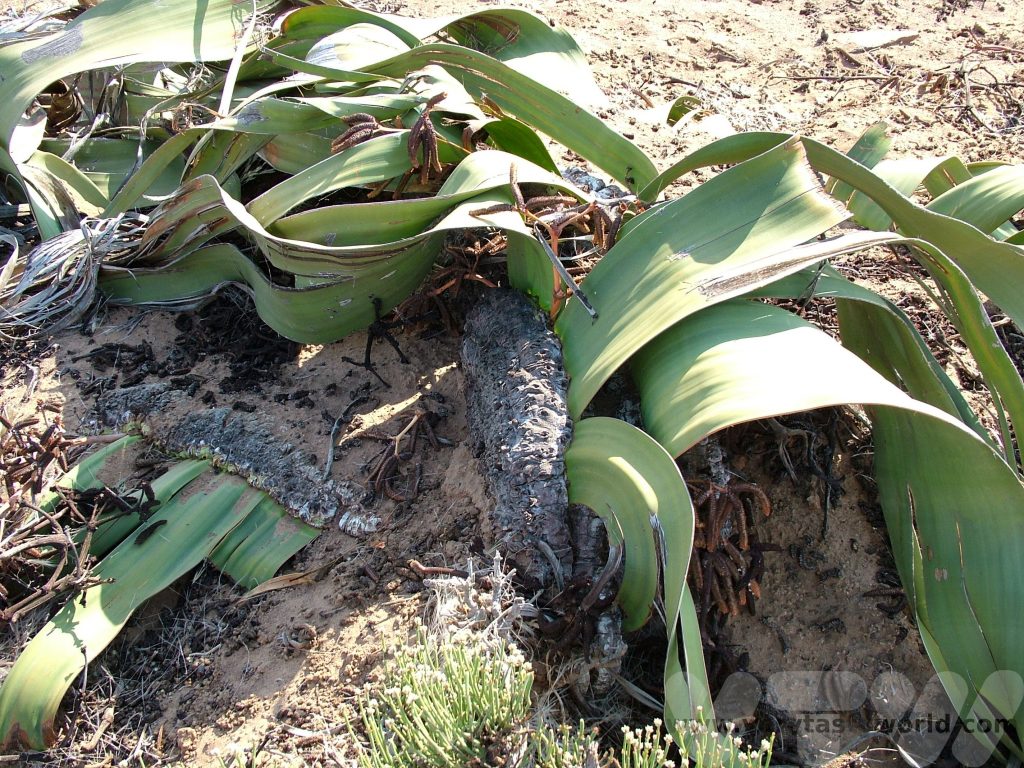
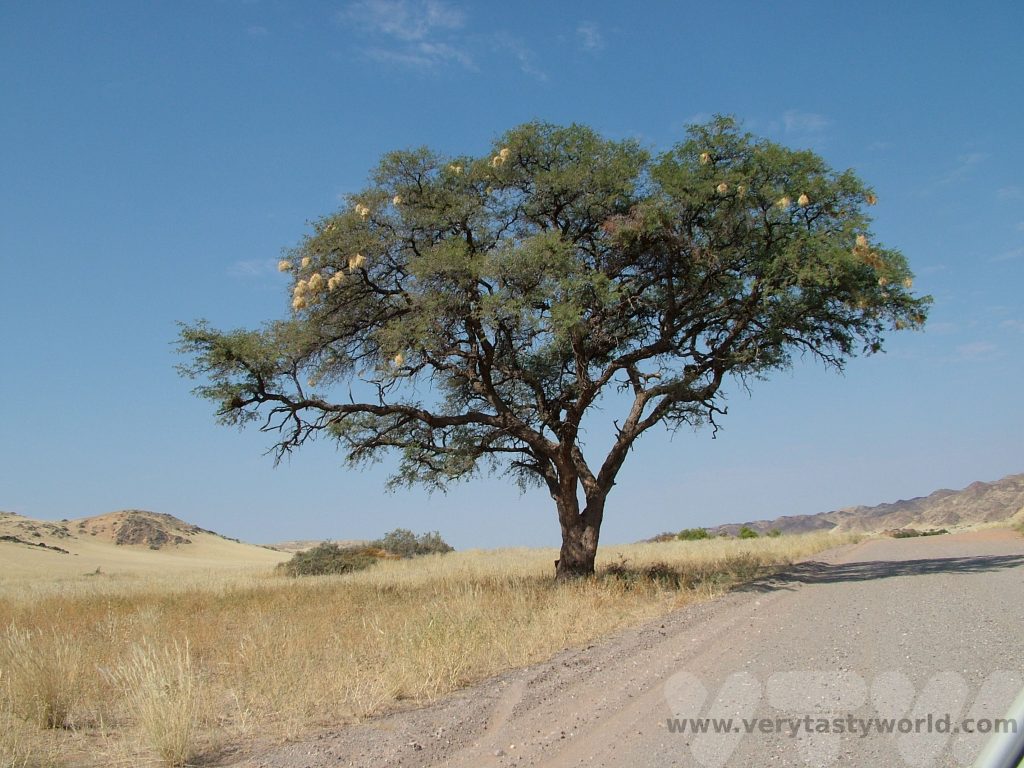
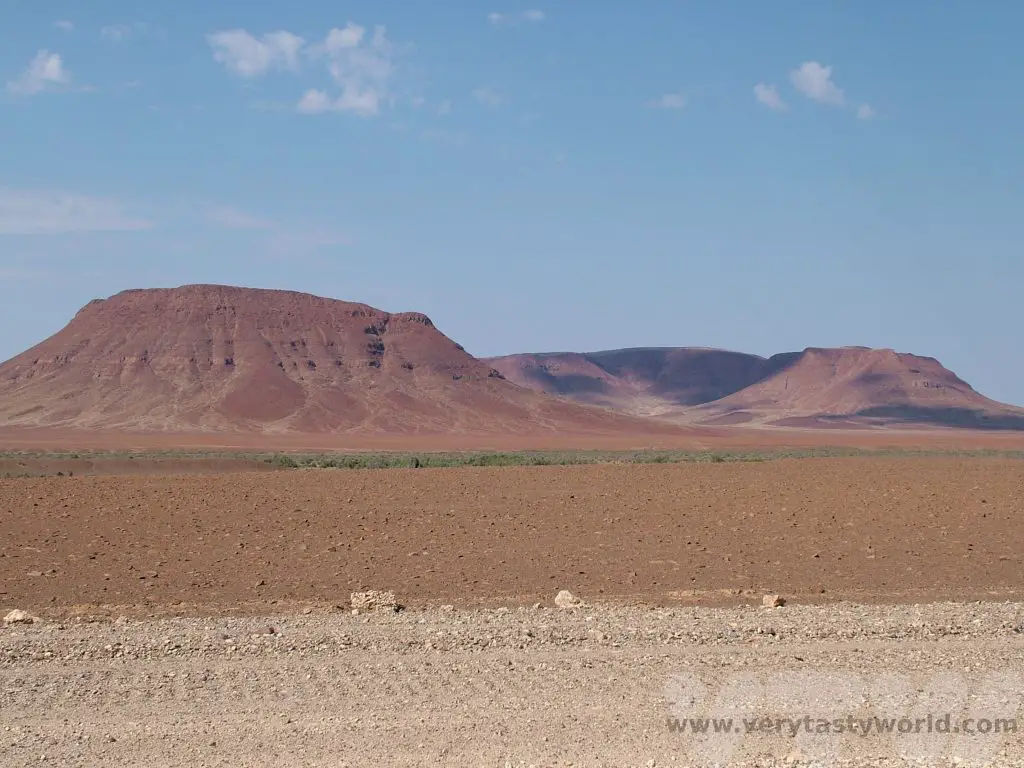

Kratie Dolphins in Cambodia
Kratie (pronounced Kra-cheh) is a laid back town in Northern Cambodia, right on the mighty Mekong river. It’s a small town that you can easily walk around and has some sights to enjoy. The most notable are the very rare freshwater Kratie dolphins, a small group of which live in the river close to the town.
They are not close enough that you can easily walk to the viewing , you need to arrange a trip, usually via tuk tuk. Most hotels/guest houses will be able to arrange this on the day, just decide a pickup time and location.
The Irrawaddy dolphins are most active in the morning or late afternoon/early evening, so it’s worth planning a trip when you are more likely to see them. Of course, everybody else will be visiting at that time too! As with all wildlife viewings, luck plays a big part in whether you see the dolphins.
The boat launch area is about 11km north of Kratie, you arrive, register and are then taken to a boat. The dolphins are a joy to watch but very tricky to photograph – you only see them pop out of the water to catch a breath so by the time you have located them and focused the camera they have vanished back into the river. Better just to enjoy viewing them.
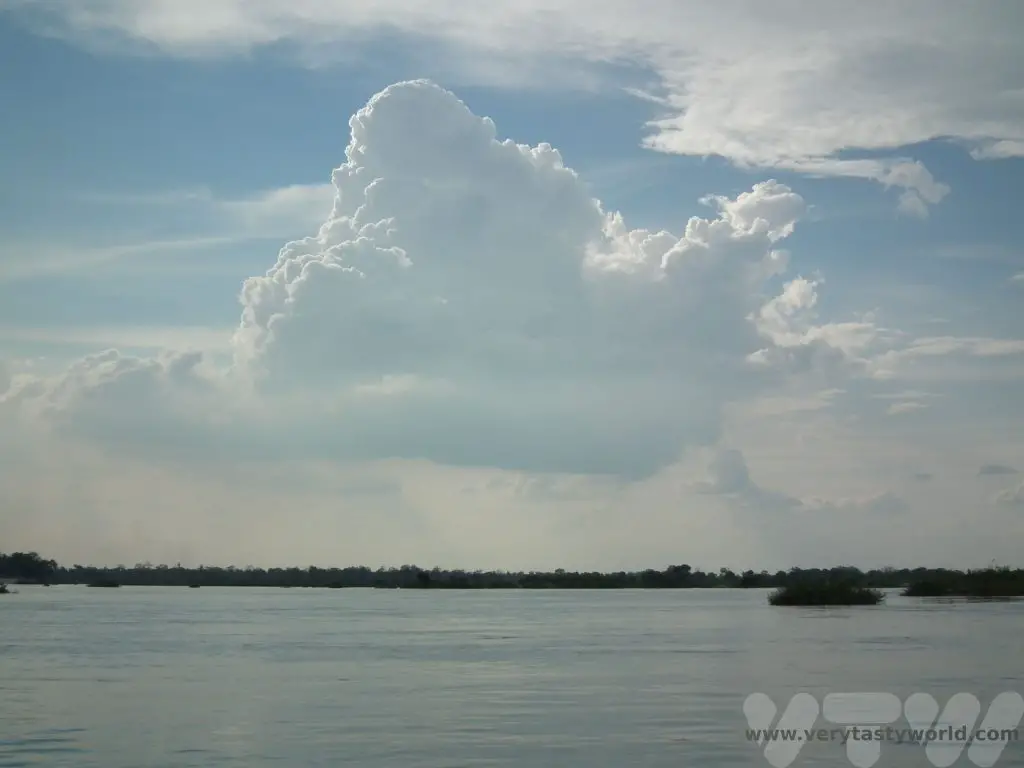
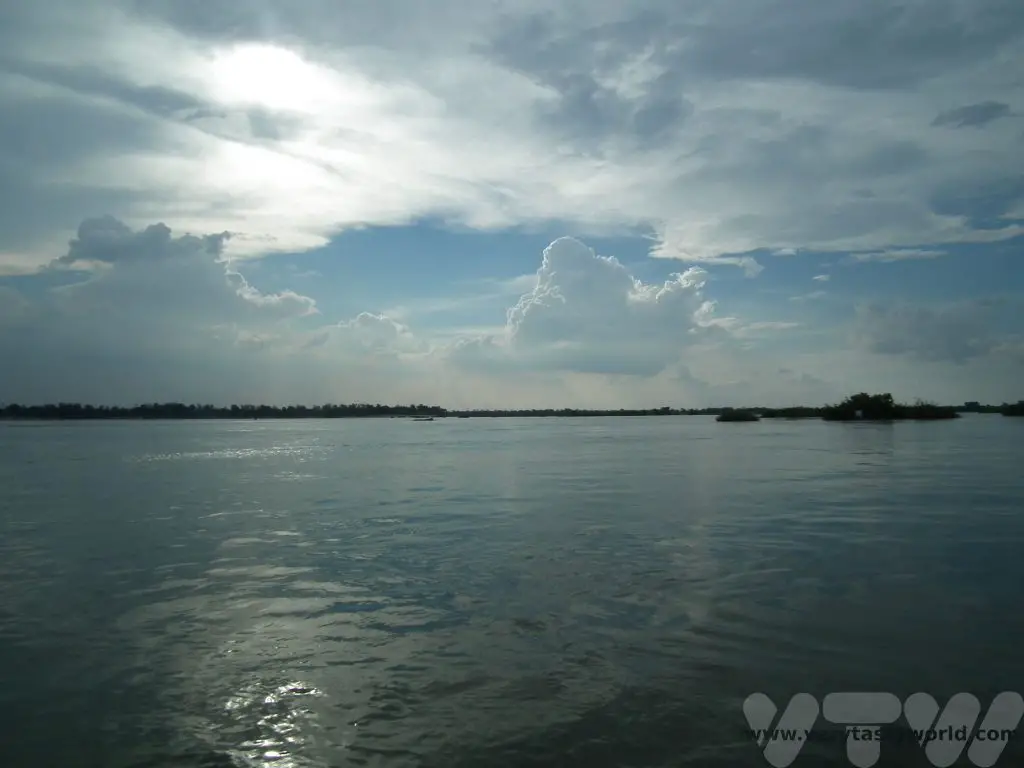
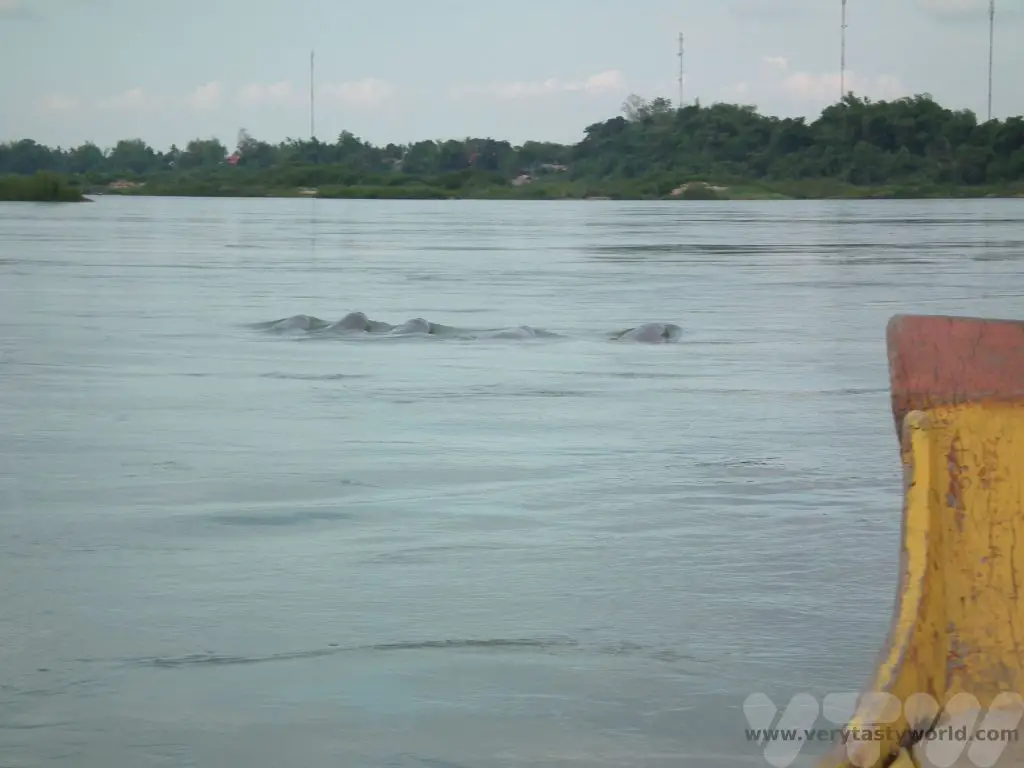
Our delightful driver waited for us while we were out on the river then brought us back to the town centre.
The Island of Koh Trong
Another enjoyable morning in Kratie can be spent exploring the Mekong island of Koh Trong. You catch a ferry from boat port and it’s a short journey across the river. Once you have landed you can hire a scooter or a bicycle and circumnavigate the island, stopping off for a swim or a drink at some of the resorts (relatively expensive) or cafe.
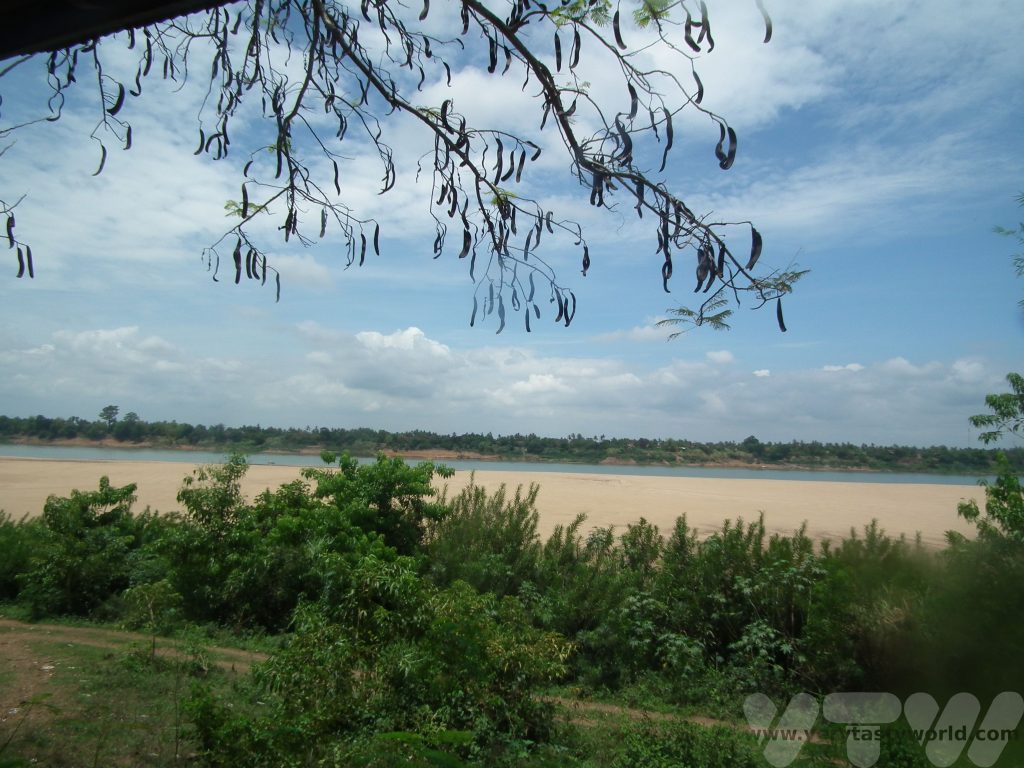
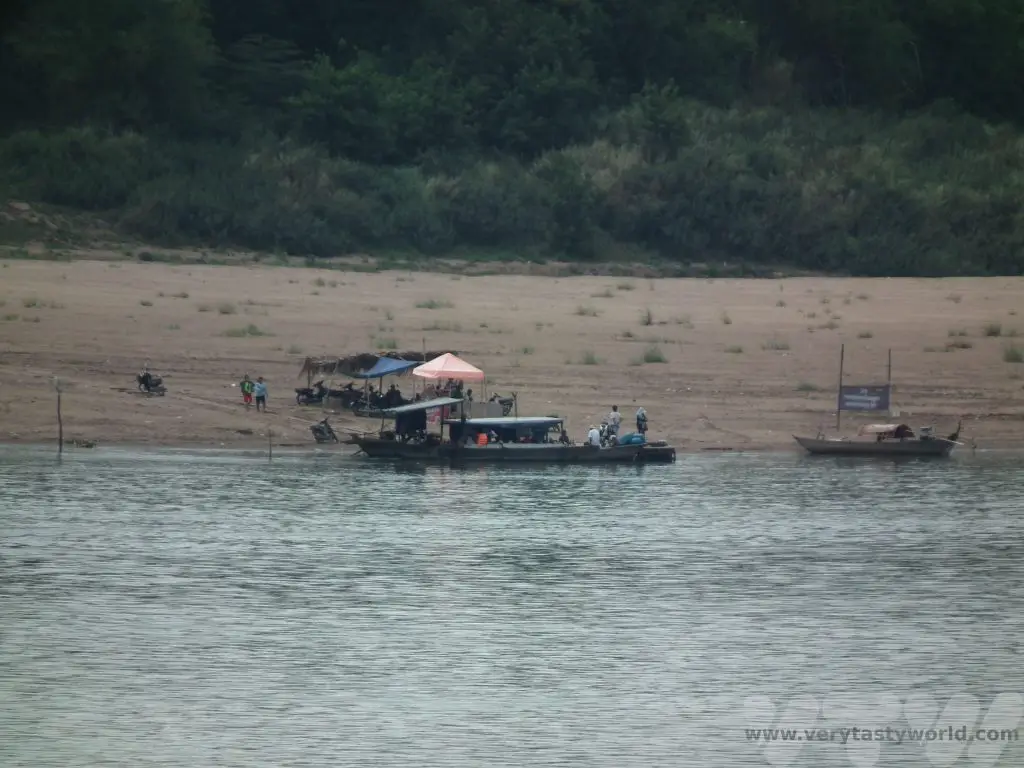
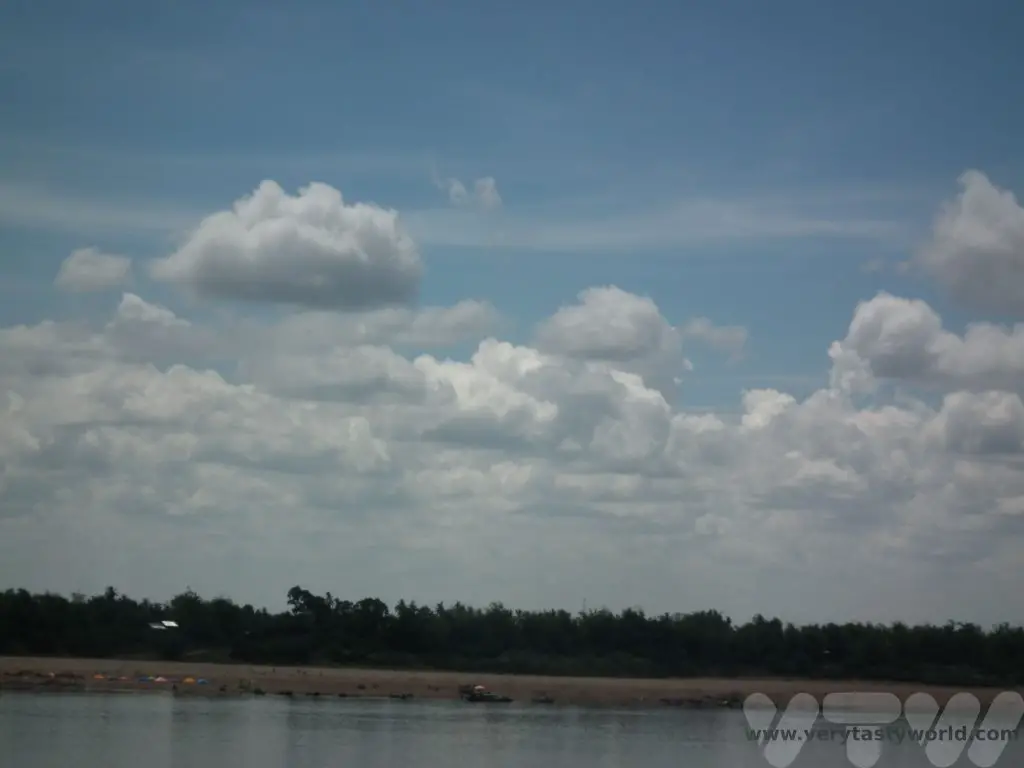
Cambodian cuisine is delicious and there are plenty of restaurants catering to all tastes and budgets.
Dining in Kratie
We enjoyed the cool and friendly Balcony Guest House and Restaurant, which offered Cambodia beer by the pitcher as you sit on the eponymous balcony enjoying a view of the river. If you happen to face bar-wards you can also learn a few words of Cambodian.
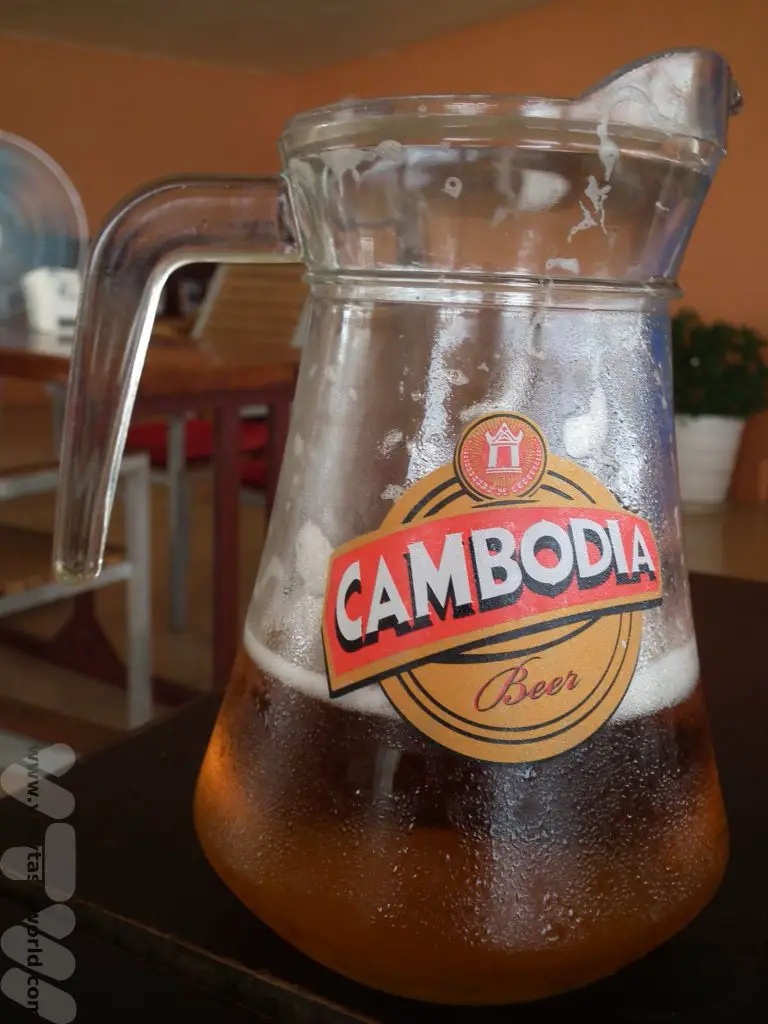
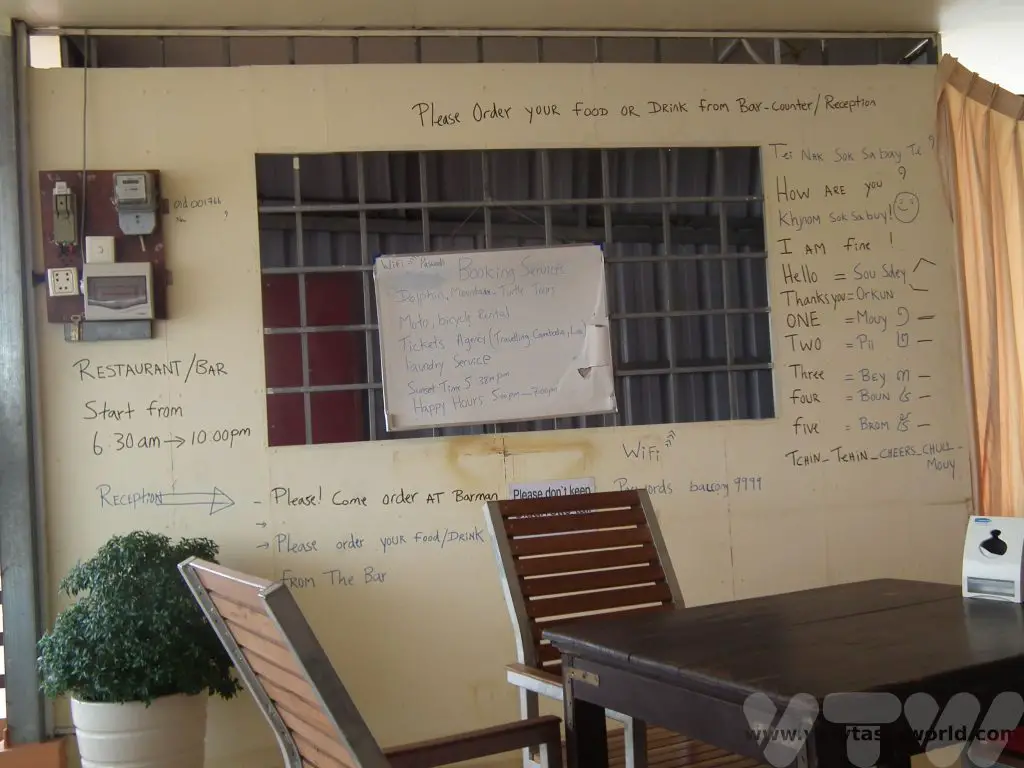
A restaurant that was rather special was Le Tonle. It’s a tourism restaurant aimed at training young people who plan to work in the hospitality sector. Tourism is a significant part of Cambodia’s economy and the idea is that young people are able to learn on the job, serving real customers.
On arrival we were greeted by not one but two front of house staff – the trainer and the trainee. This approach continued through the meal as the waiting staff took our order, served our drinks and then our dinner, guided gently by their supervisor. Both trainers and trainees were utterly delightful. Although we didn’t stay there, Le Tonle also has a guest house so that the training can extend to the hotel side of the hospitality business.
The food, also made by trainee chefs, was absolutely delicious. Using fresh ingredients the menu offers Cambodian, western and fusion dishes. Obviously we recommend the local options. A particular highlight was diced raw river fish and vegetables, marinated in a coconut and lime juice sauce and served inside a coconut shell, accompanied by steamed rice.
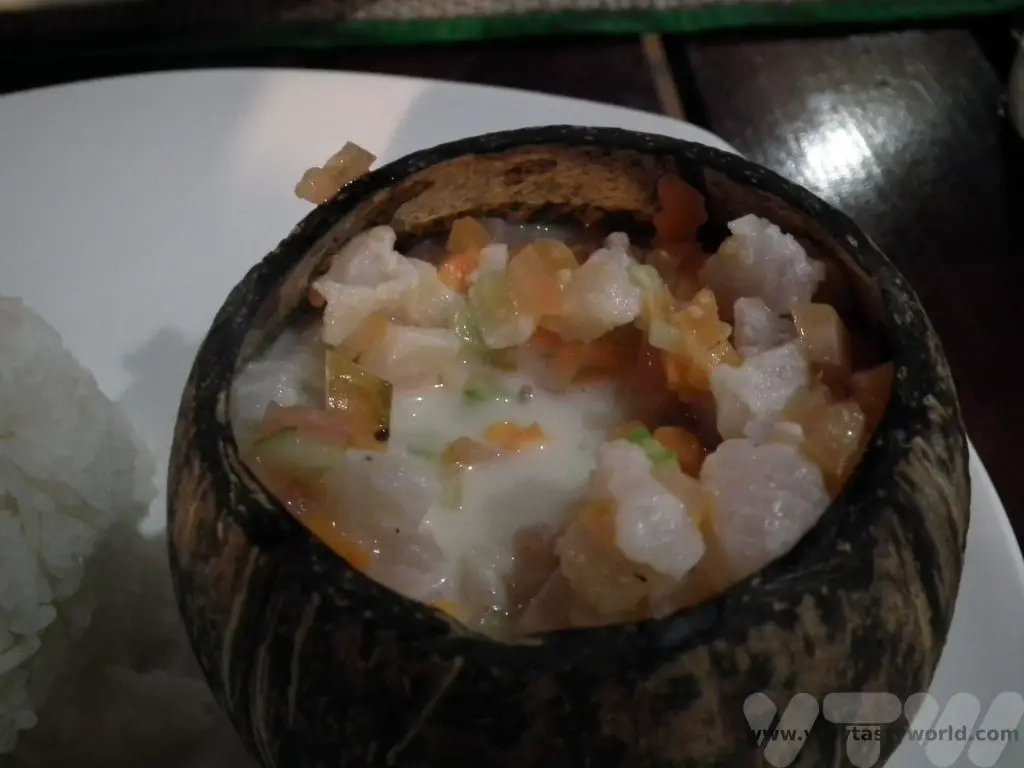
Le Tonle is a great initiative. We would love to see more social enterprise restaurants like this – especially those where young people get a chance to learn and hopefully use the opportunity to develop a career. Even if our young hosts were occasionally a little shy or they needed a bit of guidance while serving food or drinks, their warmth and enthusiasm was charming, and we wished them all well for the future.

The Roman Ruins in Jerash, Jordan
Roman Streets and Sweet Treats
The Roman ruins at Jerash Jordan are some of the best preserved in the world. Jerash is within an easy 50-ish km drive of the capital Amman. The site makes for a fascinating day trip; covering a very large area it is possible to wander all over the city. It is definitely worth finding a guide who can point out all the features and explain the history and the architecture, especially as there aren’t many signs or information points, although beware as they may encourage you to buy stuff you don’t really want to buy from various vendors who can be found waiting for tourists.
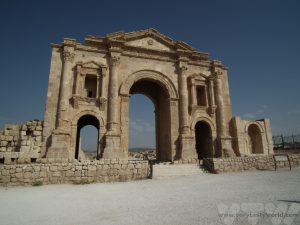
The arch of Hadrian (who had already started construction of the wall in the north of England) was erected around 129-130 AD , when the Emperor visited Jerash.
The hippodrome was an enormous arena which was used for chariot races and gladiator fights. Sometimes chariot races are re-enacted in the space. Sadly, not when we visited.
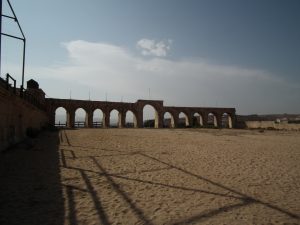
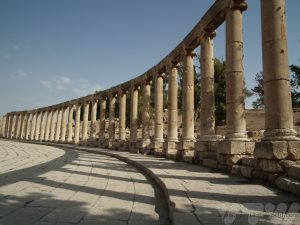
The colonnaded forum, an area designed as a marketplace but used for social gatherings, including important political meetings, is stunning. Its oval shape is very unusual.
The nymphanium, a monument to the nymphs, was fed by an aqueduct.
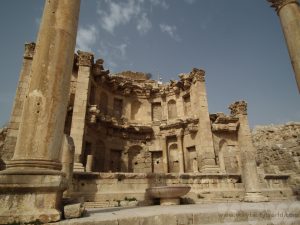
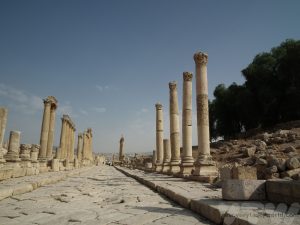
It’s possible to walk down the roman street, also known as a cardo and as straight as Roman roads are reputed to be, again lined with columns. The road’s surface is original.
There’s an amphitheatre where you can stand on the stage and let your inner thespian out. Even if you don’t feel up to a full performance of your favourite speech, it’s worth standing on the stage and just speaking – the acoustic design of the theatre ensures that your voice can be heard with remarkable clarity, even normal speech levels.
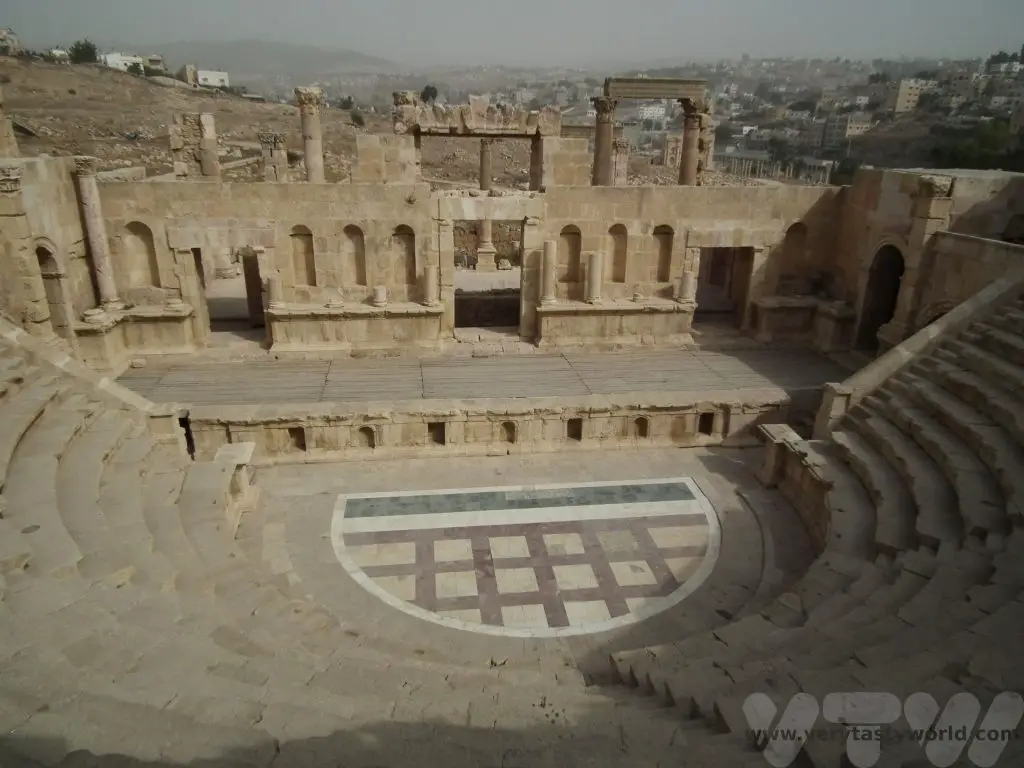
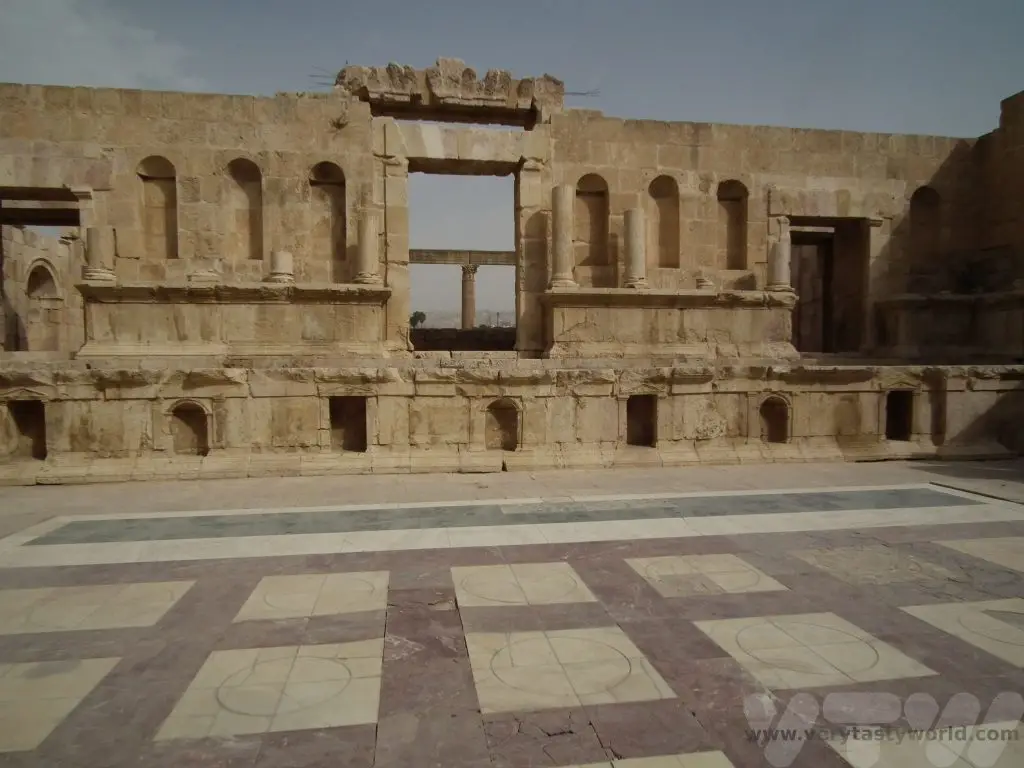
And at the end of a day’s exploration of the Roman ruins in Jerash, you are likely to be peckish. We were. Amman has some really excellent restaurants so on our return to the capital we went to Habibah to eat kanafeh.
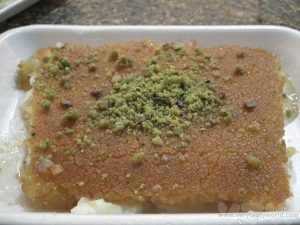
Other Posts You May Like
Jordanian Dessert – Kanafeh at Habibah
Middle eastern desserts are not only delicious they are also quite addictive. One of the defining elements of a Jordanian dessert we tried when visiting the country was the sweet, sweet syrup that soaks into and pervades the pastry or dough that forms the base. The sweetness is probably a good thing as it does limit your ability to scoff vast quantities of these scrumptious sweets.
The magic ingredient in Kanafeh is cheese. Kanafeh comprises pastry or dough, saturated in syrup and layered with a very slightly salty cheese, traditionally nabulsi or akkawi, which adds a comforting and savoury contrast to counterbalance the sweetness. Kanafeh can take a variety of forms – some use vermicelli type noodles as the base, others a pastry type dough. The syrup can be flavoured with rose or orange water to give a light fragrance to the dessert.
Habibah in Amman have been in business for several decades. It’s easy to see why. They specialise in Jordanian dessert and their kanafeh is superb.
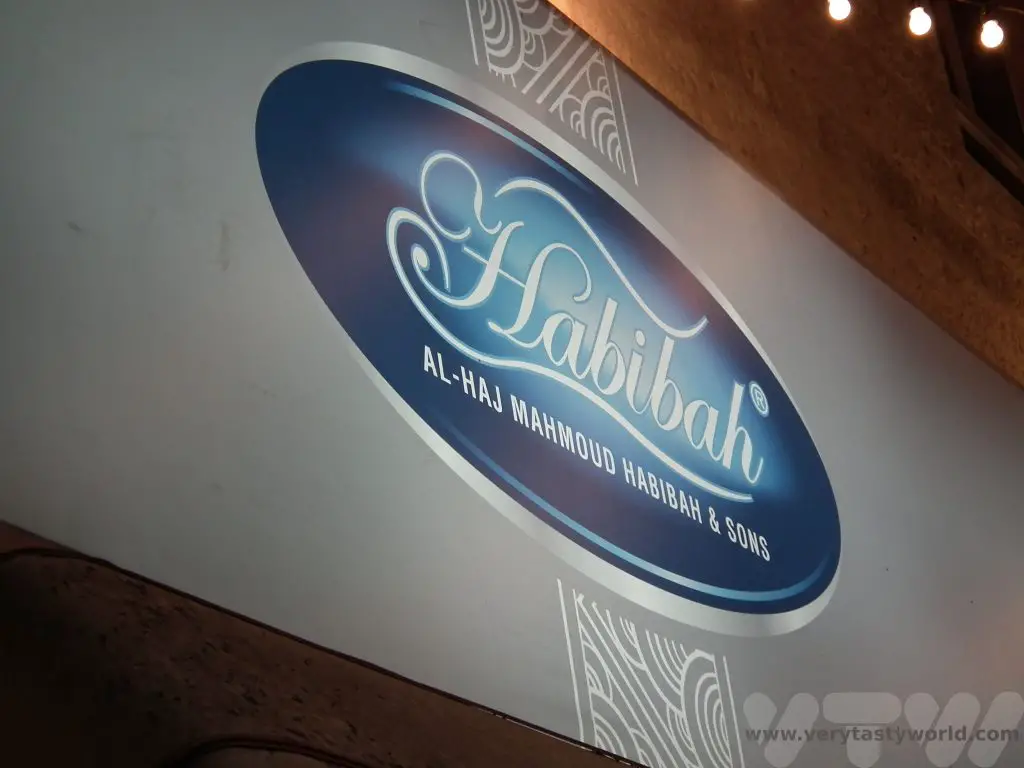
The kanafeh we tried was based on a pastry dough with layers of cheese. Topped off with pistachios for crunch and a nice green colour, and served warm, it is an absolutely delicious way to round off any meal. Or you could just order a really large portion and eat that instead of a meal – it’s worth it.
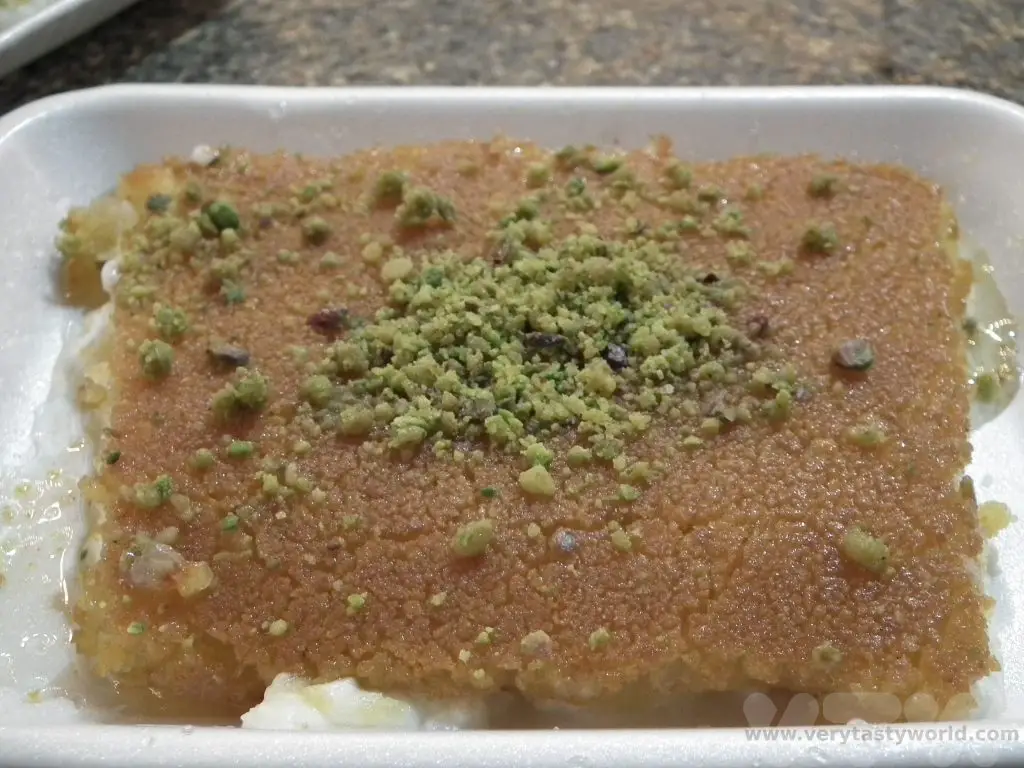
Related Posts You May Enjoy
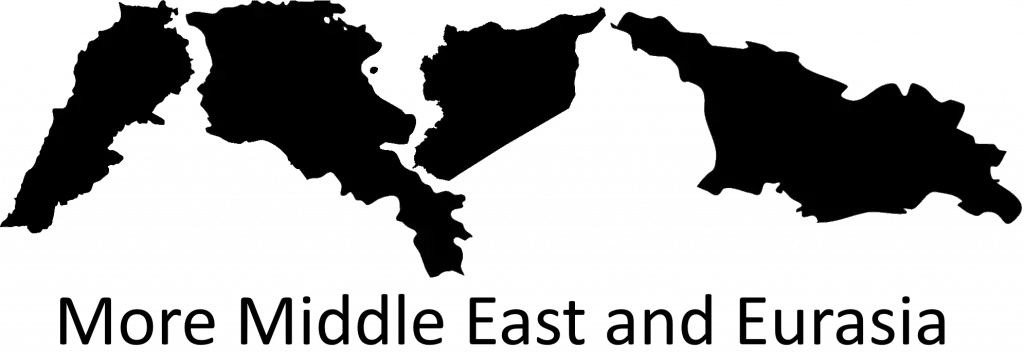
Mercado Central de Santiago
Seafood and Eat It
The Mercado Central de Santiago in Chile’s capital is one of the most amazing places where you really can see seafood and eat it. It’s a wonderful building that houses both a fish market and several restaurants. As its name suggests, it’s centrally located in Santiago, just a short walk from Plaza de Armas, and easy to reach via the metro system; L2, L3 and L5 pass close by. Puente Cal y Canto (Comb L2, L3) is the closest station and Bellas Artes (L5) gets within striking distance. And anyway, Santiago is a very pleasant city to walk around.
As the country with a coastline of over 4000 km, Chile offers some of the best seafood on the planet.
The building itself is an impressive cast iron structure, fabricated in Glasgow, and has been operational since 1872. You can walk around the entire outside of the building – there are a variety of shops to explore.
Mercado Central Santiago- The Market
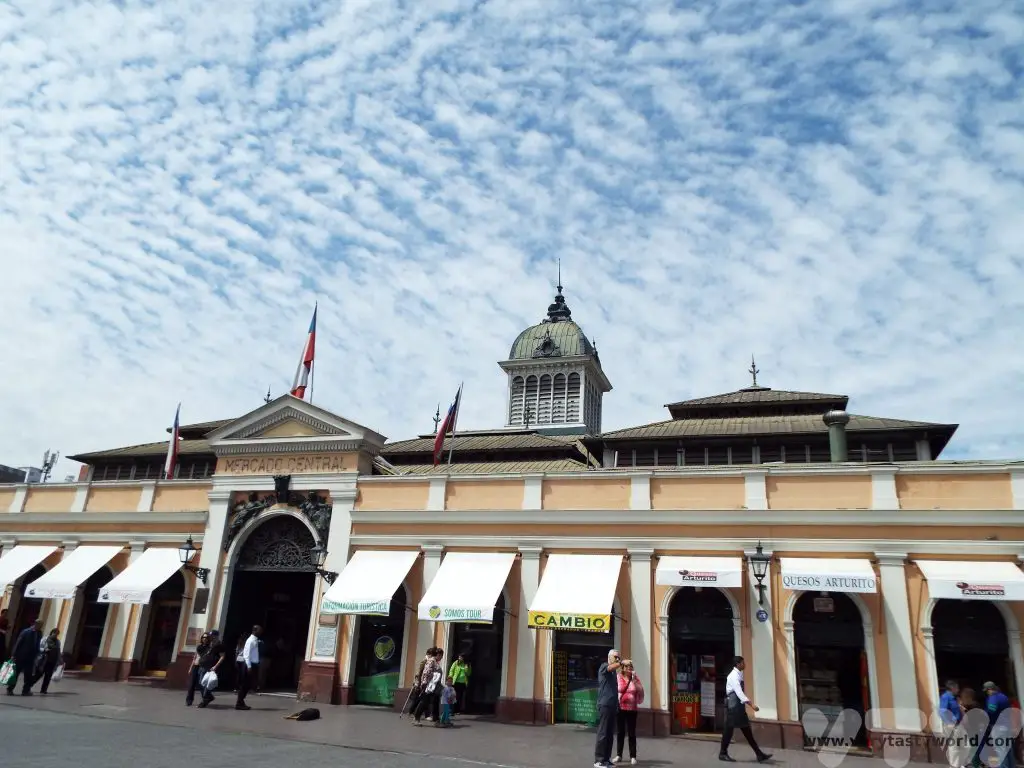
Inside the iron structure is both functional but highly decorative.
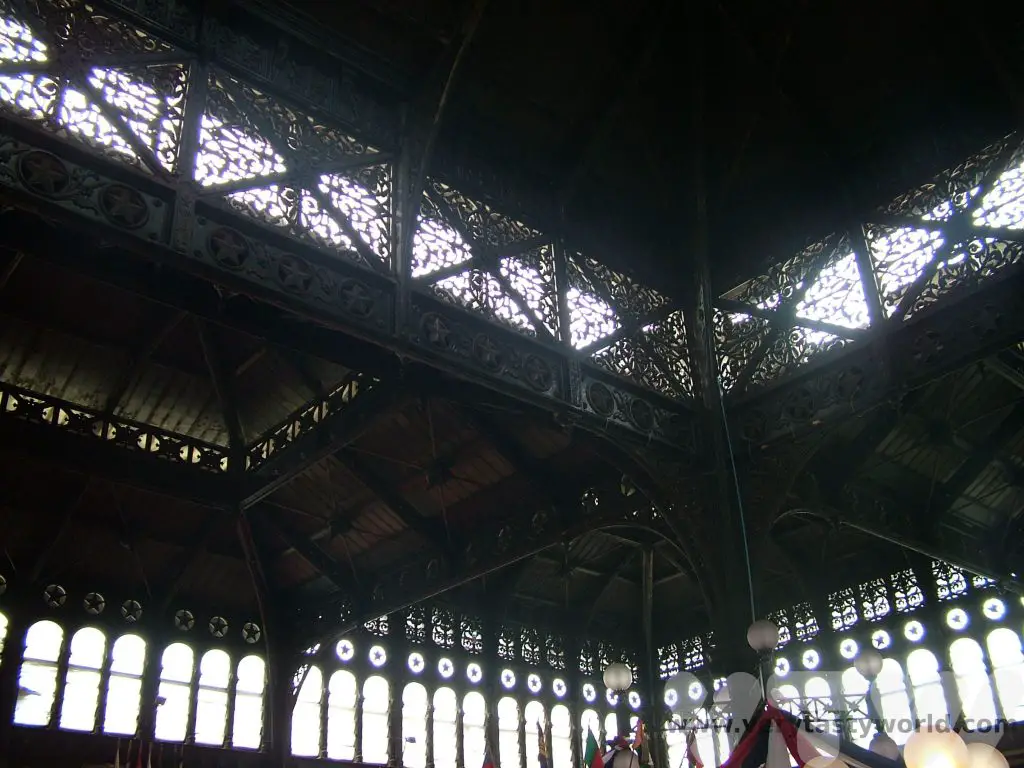
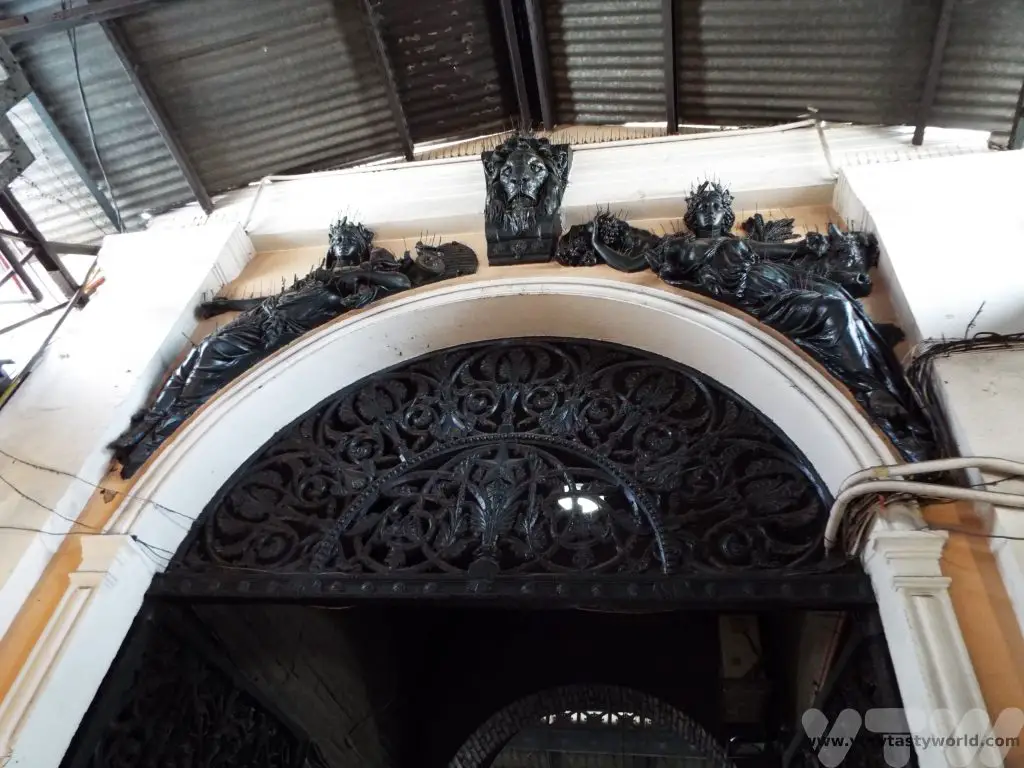
It is a working market and you can wander around the market stalls, perusing the plethora of pescatarian possibilities. As the market is known to be a tourist attraction, all the stall holders were happy to be getting on with their jobs and there were no issues with taking photos.
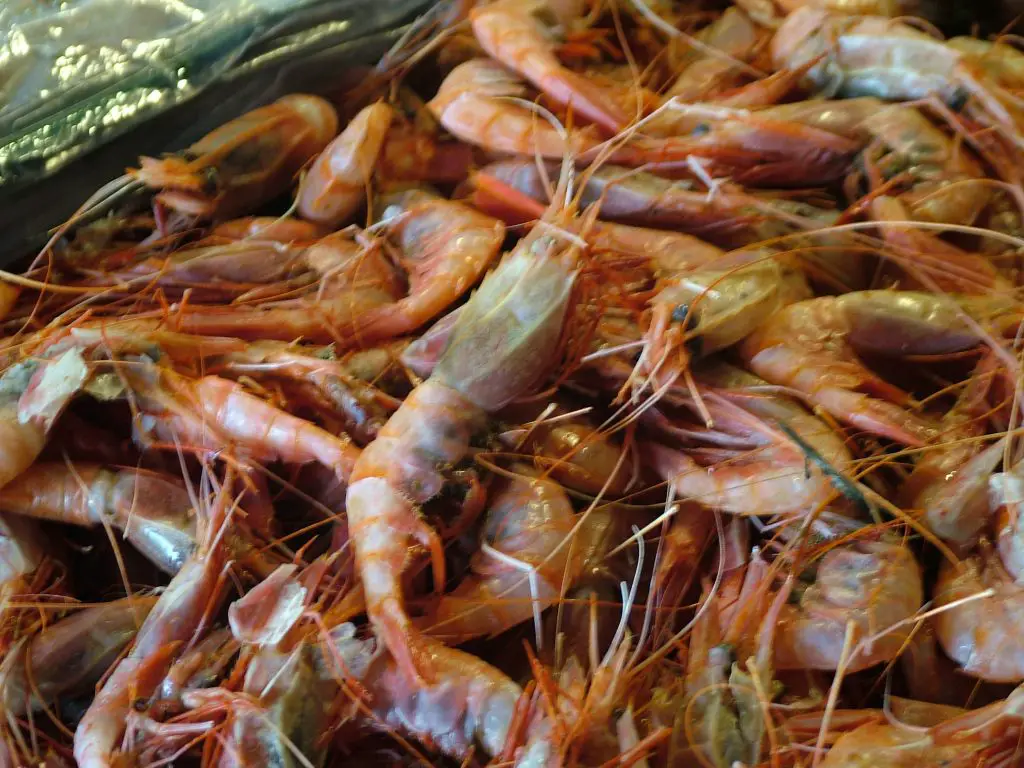
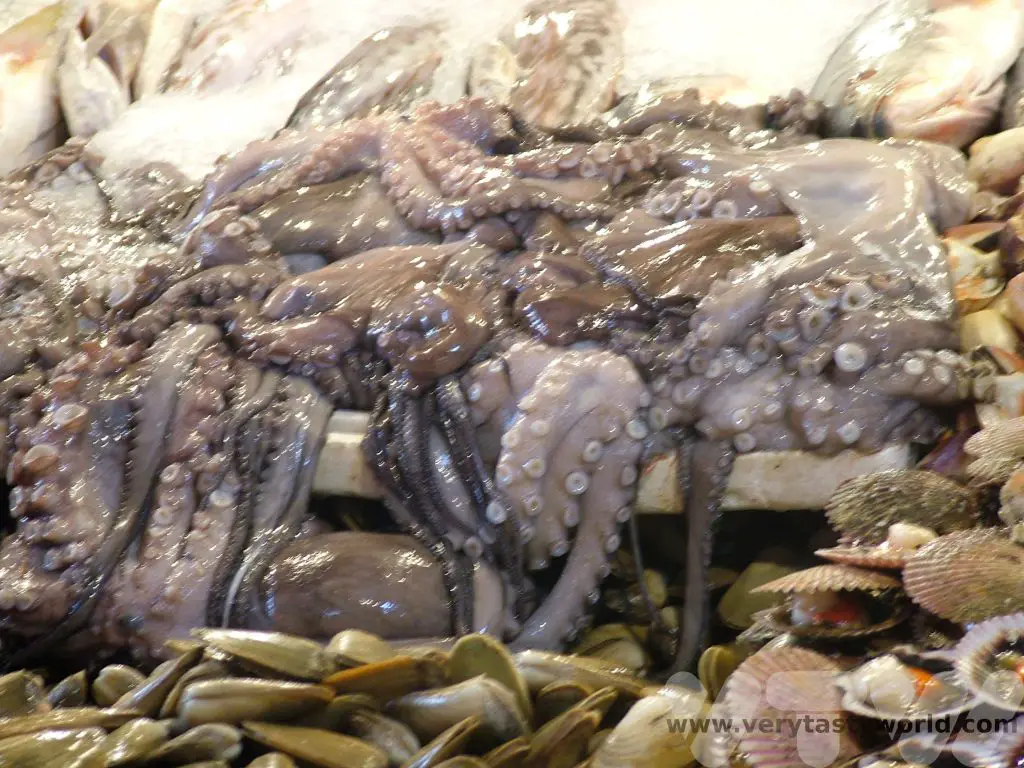
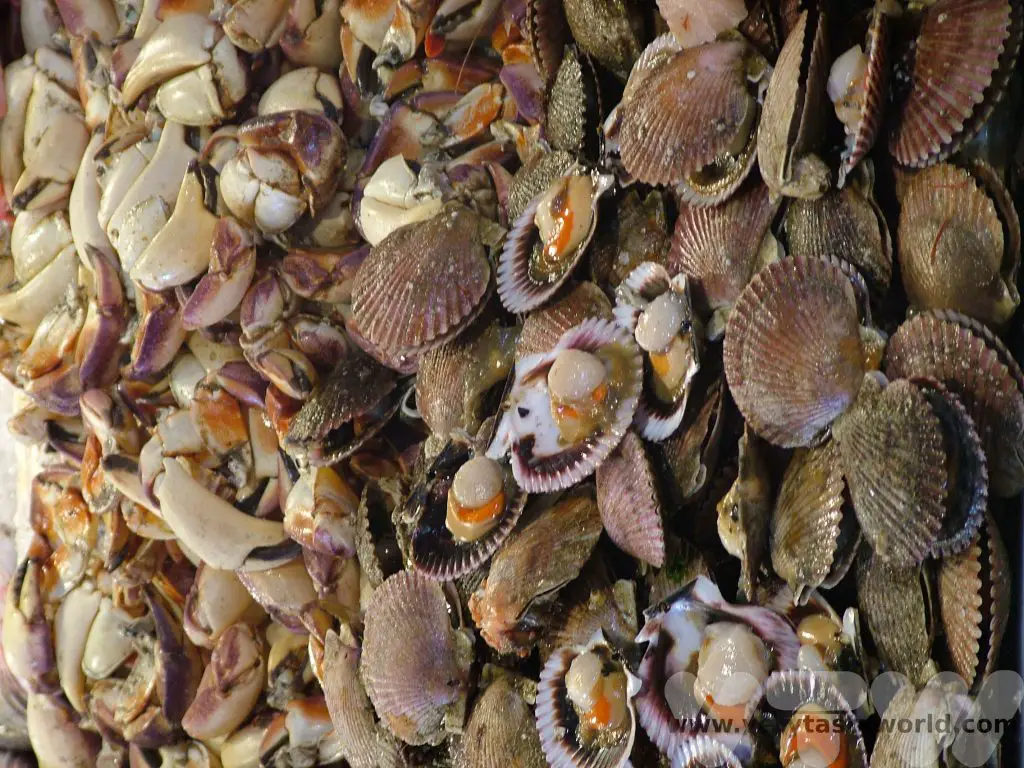
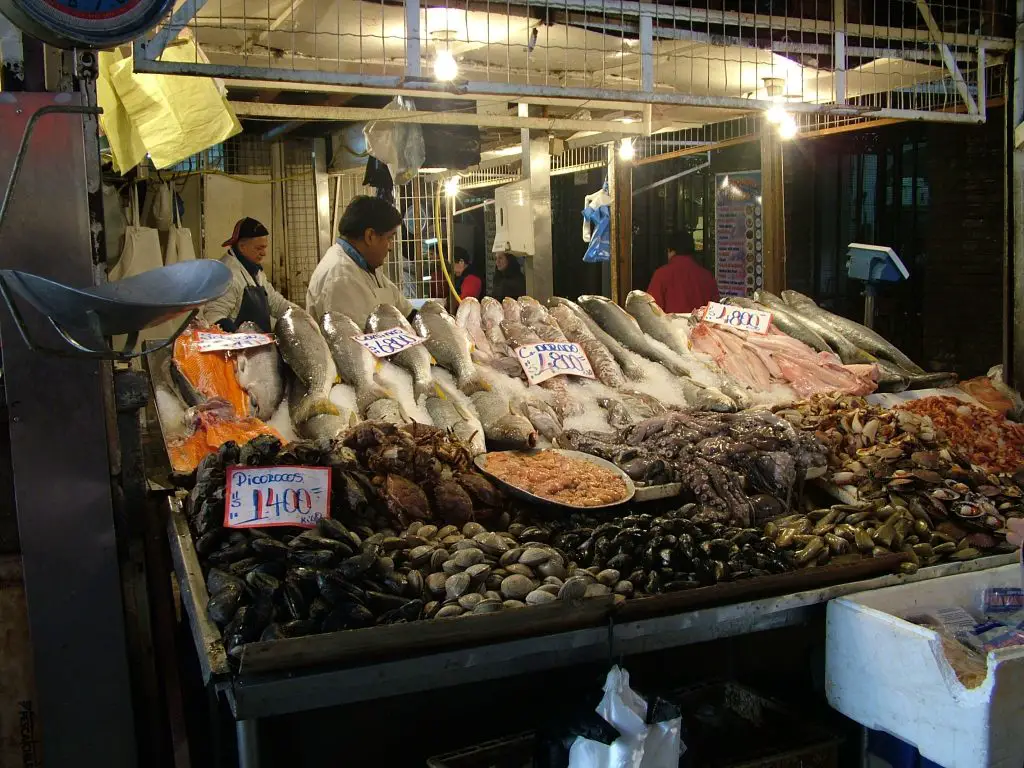
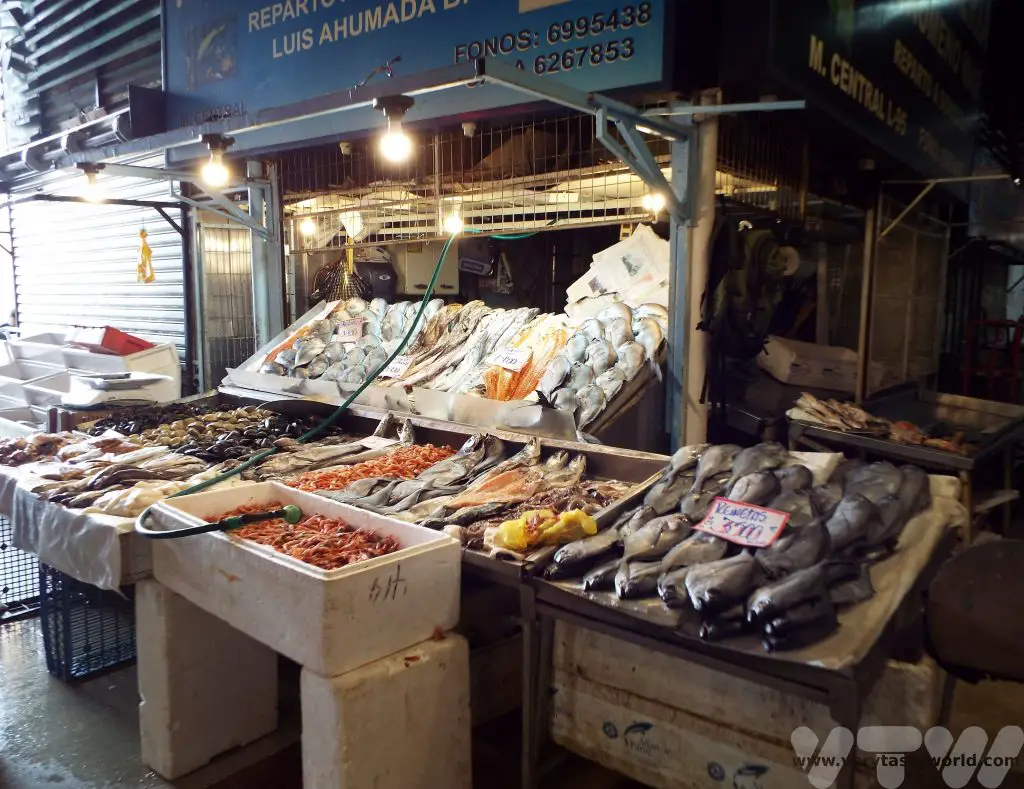
Eating At The Mercado Central de Santiago
There are all sorts of restaurants located inside the market in which you can indulge in a deliciously decadent seafood feast.
The biggest and most famous is Donde Agusto, right in the centre of the market, which was relatively expensive, crowded, had flamboyant waiters vying for business until they sat you down whereupon they ignored you in order to drum up more business and – when we visited – had irritating mariachi playing irritating guitars who expected us to pay for the pleasure of being irritated by them. Although it felt like a tourist trap the seafood was great – fruits de mer accompanied by scallops in a Roquefort sauce.
Much better is to wander around the perimeter of the market, seeking out the smaller restaurants. But you have to be a little careful.

You will find restaurateurs outside most establishments offering their cards and sometimes a variety of inducements. It’s quite relaxed though. No one hassles you too much and everyone understands the phrase, “maybe later.” These were just some of the cards we picked up as we wandered through the market and, in the interests of impartiality, we didn’t try any of these…
Some of the offers might include something like a free (minuscule) pisco sour or a dramatic flaming seafood feast offer. At El Rey De La Paila Marina, to be fair to the drama, the seafood feast which was comprised of such delights as crab, squid, prawns and scallops as well as a variety of fish, was undeniably delicious.
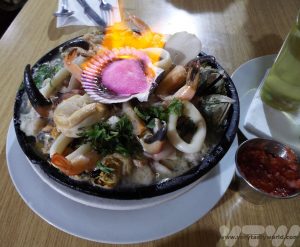
The Picoroco, Spanish for “a beak in the rock”, an apt title if ever there was one, were particularly good. These are giant barnacles which cling to the rocks on the shoreline. They do look a bit challenging, admittedly.
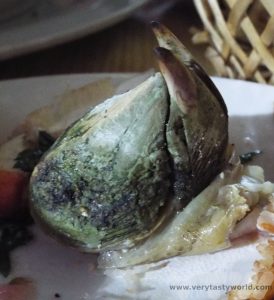
But, like many things that look a bit odd, once you get over the appearance, the taste was a revelation. They have a flavour that is very similar to crab but with a slightly chewier texture, and they were utterly delicious.
If you visit the Mercado Central de Santiago, the best advice is to seek out the smaller restaurants. Ostentation really is overrated. Our favourite restaurant was right on the edge of the market – the Donde Blanca. No English was spoken when we visited but our Spanish was just about good enough to get by. And when struggled with language the proprietor was delightful. We ordered cheviche, raw fish marinated in lime juice. The restaurant had a variety on offer, using different fish combinations, but sadly the ‘superior’ we wanted wasn’t available. The owner made a suggestion for an alternative but unfortunately we didn’t understand what a camarón was. So he trotted out to the market, picked a shrimp from one of the stalls, showed it to us, peeled it and ate it with a big grin on his face. Cheviche with shrimp, bread and salsa, all washed down with a bottle of crisp Chilean white wine turned out to be the perfect lunch.
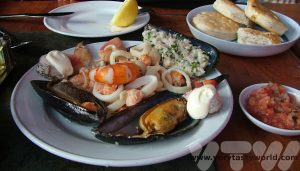
Of course, restaurants come and go and a good or bad experience somewhere isn’t necessarily an indicator of quality on a future visit.
Related Posts You May Enjoy

- Best Time To Visit Machu Picchu 2024 Update
- A 2 Week Patagonia Itinerary
- Day of the Dead in Campeche
- A Galapagos Land Based Itinerary
- RECIPE: How to Make Costa Rica’s Gallo Pinto
- A Tasty Puebla Food Tour
- Costa Rica Wildlife Sanctuary – Caño Negro
- Visit Torres del Paine National Park in Patagonia
- Atacama Desert Itinerary
